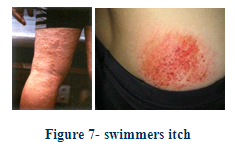The effects of eight weeks handball exercises on social development in student of middle school in khorramshahr city
Valizadeh.R1, + , Zarghami.M 2, Baledi.R3, Hosseini.A.S 4, Feghhi.I5
1,5 Department of genral physical education, Omidiyeh Branch, Islamic Azad University , Omidiyeh, Iran
2Department of Sport Psychology, Shahid Chamran University , Ahvaz, Iran
3 Department of physical education, Abadan Branch, Islamic Azad University , Abadan, Iran
4 Department of physical education, Behbahan Branch, Islamic Azad University , Behbahan, Iran
Social development is one of notable aspects of exist every person that not only affect to compatibility with suburbs but effect to range of educational success and advance In future. This aspects of development for example somatic or mental is a continues quantity and is perfected progressively. This is a semi experimental study that has been done by pretest & post-test design and control group. In this research the population of research was all men Student (n=7116),(age= 13-18) of middle school of khorramshar city in years of 2005-2006. The statistical sample in this study was 40 person, whom was selected by randomly method .that divided by experimental (n=20) and control (n=20) group. For evaluation of social development the (Weitzman.1981) questioner was used. The reliability of this questioner accepted by kronbakh alpha. At first statistical sample participated in pre-test and then divided by experimental and control group. Experimental groups for eight weeks, three sessions a week and each session for 90 minutes done handball exercises. Data analysis by computer using SPSS software and statistical methods of Descriptive and inferential (ANOVA &-test) was performed. Also the comparison, results of control and experimental groups showed that eight weeks handball exercises had significant changes on social development and all of aspects of experimental group, except hopefulness and optimism. (a ≥0/05)
Key words : handball, Autonomously, Responsibility, Relation and Compatibility, Hopefulness, Whole Social Growth
1. Introduction
Communication and how make relationship with together was the favorite case of the worlds men during the past and now. Man kind always made ready the way for affairs as the basis of life continuation and by this way man kind could gain their basic needs. In present century which is called communications century the value and importance of making relation with the world increased by means of a group life and making can yield important results against difficulties and also exploring the unidentified world. Its important to have true social development means growth of mans behavior in social relations as can be relevant and have a harmony with his society. A man is social when not only is beside others, but also cooperate with them [Aliakbar.1995].social growth is the indicator of those abilities that in connection with environment shows us the amount of learning. in the survey of social development, the purpose is indicate of that how much people can do daily activity of life and social communications[ Heshmatollah.1998]. Social development is another kind of growth that its recognition is more difficult than mental growth [Alice.1997].So it's more important for teenagers and young people who are at the beginning of progress and experience path. The importance of adolescence period is because of the growth of body forces and also due to expansion of mental potentials that arrives him to be a social and complete personality. Everything is changing in these years[2].So it should be expanded ,That is a man should be capable to obtain his independence, responsibility and communication with others as he needs that is gain an acceptable social growth. One of the ways to achieve social growth is sport exercise with it shows as a healthy way. Team sporting fields like handball can play an important role in social growth. Alinezhad says: body activity is on of principal elements of the children and teenagers. Body exercises is very effective for expanding of physical performances like motional skills and power of muscles and physiological potentials and energy production and working feed back and in other hard in children mental and social growth[Hamid.1997]. Mohammadi in a search by use of Witzmans social growth test and by compare individual athletes with team athletes and the non athletic students resulted that the team athletes in compare with two other groups have a greater social growth average [Reza.1999].Also vichel in an article under this title training of social skills by body training writes motion activities and sport. Has a great ability to grow positive social skills on students [Vigil.1996].And also based on deyvis and his colleae use in the book of psychology and sport, sport and body activity has social effectiveness [Davise et al. 2000].So researcher try to engage group team exercises to assess amount of social growth and any changes in the students. In one of sport fields like handball same as other group fields, favorite result occurs when the men in addition to have series of personal characters like responsibility, should profit from harmonic communications for group actions. So this research wants to study the effect of eight weeks handball exercises on social development (growth) of male students of intermediate course in khoramshahr, in a case that represents essential directions to teachers and parents and students.
2. Methods
The method of this research is semi experimental that studies the effect of eight week handball exercises on social development of male students of intermediate course khoramshahr bye use of pre-test research and post- test and control group.
2.1. Society and statistical sample.
Statistical society of this research consist of 7116 male students 13-18 year old in intermediate course in khoramshahr on education year 2005- 2006. In this research, sampling is done in randomly case, so khoramshahr town divided in five areas and then selected one school from each area in random case. Then divided 200 questionnaire randomly among the students of these five schools and so 40 persons who their grades were the least in social development (growth) at others ratio, were selected as the statistical sample.
2.2. Measurement tools.
From witzoman's social development questionnaire which consist of 27 questions is used for data collecting of this research. Some of the questions have 3 choices and others have 4 choices. This questionnaire shows the amount of social growth since 13 to 18 years old and has four dimensions which are: self-sufficiency (autonomy), responsibility acceptation, compatibility and communication with others and hopefully. witzman's social development is made by Ali's witzman. this questionnaire translated to persian by Sima Nazari[Noshabadi.2000].And Abassi has reported the final coefficient of the questionnaire 0/84 on the teenages 13 to 18 years old in tehran and esfahan cities[Heshmatollah.1998].For final study in this research , kronbakh's Alfa method was used which it's calculated amount is (r=0/81) in p<0/05 meaningful level. Also Abassi has reported the current coefficient of this questionnaire on the 13 to 18 years old teenagers in Tehran and Esfahan (r=0/75) which is on the level of p<0/05 meaningful [Heshmatollah.1998].There are 57 numbers in this questionnaire in all, which based on reply letter and with regard to person's choices, the grade of 0.1.2, 3 was given to the person in each question. Trainee select the best answer based on his idea, after the reading of the question and then marks it with(X).After the trainees answering, refer to answers key and the grades were given according to selective choice and the general grade calculates for him.
2.3. Statistical methods.
For data analysis, used from descriptive statistic (mean, standard deviation, tables, diagram…) and deduction statistic (variance analysis and t-test) which all the statistical operations were done by excel soft ware and SPSS® (version 11.5) with error (fault) modulus of a ≥0/05
3. Results
3.1. Descriptive part of research findings.
Table (1) shows the related data of descriptive statistic of general grades in social growth and its dimensions.
Table1: descriptive statistics of related grades to whole model in pretest

Also the random selection method is used to assign control and experimental group, which the related in formation of (data) to mean and standard deviation of the grades of social growth and it's dimensions for two experimental and control groups in the per-test said systematically in the tables(2,3)
Table2: Related grades to social development and its dimensions in experimental group in pre-test

Table3: Related grades to social development and its dimensions in control group in pre-test

3.2. Deduction part of research findings.
In this section the use of deduction statistical methods show there is no meaningful difference between two experimental and control groups because of social growth and it's dimensions in pre-test on the level of a ≥0/05. Table4.The comparison of the variances of both two groups, shows, there is no meaningful difference between two groups in per-test.
Table4: F table (comparison of variances) in per-test

In the other hand, to ensure the results of table(4).For comparison of the means of two groups in social development and it's dimensions , T-test is used which the results in table (5).Shows there is no meaningful difference on the level of a ≥0/05 in per-test between two groups.
Table5: independent t-test, comparison between mean of two groups in pre-test

Since the results of tables four and five show that there is no significant difference between two groups in the level of a ≥0/05 in pre-test. So in this section, we compare post-test results in two experimental and control groups.
3.2.1. Table number(6).the results of independent t-test between two groups shows that there is significant difference between two groups in the meaningful level of p-value=0/000 . Also the results of this table shows well that the mean grades of experiential group are higher , in compare with control group. After 8 weeks handball exercises. So handball exercises have had a positive effect on the social development variable.
Table6: independent t-test for compare of social development of two groups in post-test

3.2.2. The data of table number (7).Show that there is significant difference between two groups in the meaningful level of p-value=0/046. Also being high the mean of autonomy in experimental group shows that handball exercises have had a positive effect on this variable.
Table7: independent t-test for comparison of autonomy of two groups in post-test

3.2.3. Also The data of table number (8).Shows that there is significant difference between two groups in the meaningful level of p-value=0/000. In other hand the comparison of the means shows influence of exercise on experimental group. So the results of this theory show that handball exercises could have positive influence on responsibility.
Table8: independent t-test for comparison of responsibility of two groups in post-test

3.2.4. The data of table number(9) shows that there is significant difference between two groups on meaningful level of p-value=0/005.Also autonomy mean of experimental group shows handball exercises have a positive effect on compatibility and make relation.
Table9: independent t-test for comparison of compatibility and relation of two groups in post-test

3.2.5. The data of table number (10) shows that there is no significant difference between two groups in the meaningful level of P-value=0/290.In fact this meaningful level shows that handball exercises have no influence on the dimension of hopefulness and optimism.
Table10: independent t-test for comparison of hopefulness and optimism of two groups in post-test

4. Discussion and conclusion
The findings of the research show that eight weeks handball exercises have influence on the sense of male students' autonomy. In other word, the students' autonomy who takes part in handball exercises was higher than others, meaningfully. It seems the completed researches have done more on social development from. and we cant find few researches which survey social development dimensions separately, so the results of this research in compare with stonsons research findings based upon sociality and autonomy by sport is weak or unremarkable a bout autonomy are disharmonious[Stevenson.1975].incompatibility of this finding with the findings of has done research ,may be for difference in place execution or the kind of sport field[Heshmatollah.1998].considering that the amount of obtained autonomy from participated students in handball group(team)athletes are good situations for developing the teenagers and youth autonomy level. Having the sense of autonomy in an acceptable extent has a good results on the individual life , in a way that person can take regarded decisions in the life with high self-confidence and access to his purpose just based on self-abilities and without depending on others. Having such men beside each other in a society cause a progressive society.
In this research, the comparison of the sense of responsibility in experimental group and control groups shows that there is a significant difference between the senses of responsibility in two groups after eight weeks handball exercise. It means responsibility among the students who took part in handball exercises in compare with others who did not participate in exercises is on higher level. in the researches, responsibility analyze as one of the dimensions of social development and hasn't studied separately. Any way the results of this variable are the same as many results of other researchers[Nico .2010].There from peoples responsibility is on of the development particulars in each society, we hope by people participating in grouped activities, more the society toward development.
The results of comparison compatibility and make relation with others between experimental and control groups after eight weeks showed that there is significant difference between two groups. In the other word compatibility and make relation with others among the students who participate in grouped handball exercises in compare with those who haven't participated are in a higher level. That these findings have harmony with other findings of researches[Daniel et al.2010., Marilyn .2009., Richard et al .2009., Laura et al.2009., Elizabeth et al 2009., Sam.2008., Gregory.2008., Philip et al.2007., Michael et al 2005., Michael et al .2000., ]
the results of comparison dimension of hopefulness and optimism between experimental and control groups after eight weeks showed that there is no significant difference between two groups. In the other word hopefulness and optimism of students that participate in handball exercise with those who didn't participate approximately was the same. These findings have no harmony with many other researches[Nico.2010.,Joseph et al.2007., Snyder et al .2006.,Suzanne et al.2006.,Cindy et al.2006]. Discordance of this finding with the finding of accomplished research, May be due to reasons like literacy level, culture and economy of statistical society of this research with other researches.
Also the results of comparison of the total social development in experimental and control group showed that there is a significant difference between the social developments of two groups after eight weeks handball exercise. It means the students who participated in handball exercise, in compare with those who didn't participate gregarious exercise, Have a higher social development, meaningfully. This finding has a harmony with findings of many other researchers[Fruchart et al.2010., David et al .2010., Michael et al.2006., Sarah et al.2009., Şenay et al.2009., Wylleman et al.2009., Gillet et al.2009., Mary et al.2009., Homas et al.2009., Eva.2009., James et al.2008., Athanasios et al.2008., Raphaël et al.2007., Julie et al.2007., Michel et al.2007 ]
Since the obtained amount related to students' social growth who participated in handball exercise is in a acceptable level, we can understand that handball as a gregarious sport. Brings development and higher students social growth. Having social developed people means to have men who can do their affairs independently and under take their responsibilities in different affairs and in this are compatible with another people, groups and institutions. Also can do healthy and beneficial relationship, combined with mutual respect. Such capability, allows the person that stable against in daily life problem and don't down against them.
5. Acknowledgments
Special thanks than all friends that help me about do this study and I wish they happiness.
6. References
[1] Aliakbar SH.N., The role of extracurricular activity in adolescent education .fifth edition. Etelaat publication .Tehran. 1995.
[2] Alice V., Social development (for youth and families). Translater by N.Sima, seventh edition, association of parents and coaches, Iran, 1997
[3] Athanasios G.P., George A., Periklis K., Alexandros S. Social agents, achievement goals, satisfaction and academic achievement in youth sport . Psychology of Sport and Exercise.2008,9(2):122-141
[4] Cindy L. J., Kara B.W., Work Hope: Development and Initial Validation of a Measure . Journal of Counseling Psychology.2006, 53(1):94-106
[5] Daniel F.M., Mary A.H., Damon P.S. A., Stephen W.D., Organizational justice in sport . Sport Management Review.2010, 13(2):91-105
[6] David M., Vannessa J.T.. Need support and behavioural regulations for exercise among exercise referral scheme clients: The mediating role of psychological need satisfaction . Psychology of Sport and Exercise.2010, 11(2):91-99
[7] Davise B., bull R., roscoe J., roscoe D., physical education and the study of sport. Indiana State University.2000
[8] Elizabeth R., Dawne L., Beth H., Barbara H., Helen P., Evidence for the validity of the Children's Attraction to Physical Activity questionnaire (CAPA) with young children . Journal of Science and Medicine in Sport.2009, 12(5):573-578
[9] Eva B., The effect of moderate exercise on growth and aggression depending on social rank in groups of Arctic charr (Salvelinus alpinus L.) . Applied Animal Behaviour Science.2009, 119(1-2):115-119
[10] Fruchart E., Pâques P., Mullet E., and Decision-making in basketball and handball games: A developmental perspective . Revue Europeans de Psychologies Appliqué/European Review of Applied Psychology.2010, 60(1):27-34
[11] Gillet N., Berjot S., Paty B., Profile motivational et performance sportive . Psychologies Française.2009, 54(2):173-190
[12] Gregory C. J., George B.C., the Impact of Sport Management Students' Perceptions of Study Abroad Programs on Their Intentions to Study Abroad . Sport Management Review.2008, 11(2):149-163
[13] Hamid A.A.N., Effects of physical activity on children's growth. Second Congress of Sports Science with an emphasis on primary schools, first edition, physical education of education ministry,1997
[14] Heshmatollah A., Comparison of adolescents social development (13 to 16 years old), blind, semi-sighted vision and cities of Tehran and Isfahan. Psychology Masters thesis of Exceptional Children. College of Psychology and Educational Sciences. T.Allameh University .1998
[15] Homas D.R.T, Brian C.F., Donna S., Mediators of affective responses to acute exercise among women with high social physique anxiety . Psychology of Sport and Exercise.2009, 10(5)573-578
[16] James S., Dwight H.Z., Jacqui C. Development through Sport: Building Social Capital in Disadvantaged Communities . Sport Management Review.2008, 11(3):253-275
[17] Joseph C., Patrick C.L., Fiona D.,
The impact of hope, self-esteem, and attribution style on adolescents' school grades and emotional well-being: A longitudinal study
. Journal of Research in Personality.2007, 41(6):1161-1178
[18] Julie C.S., Philippe G.S. Self-determination of contextual motivation, inter-context dynamics and adolescents' patterns of sport participation over time . Psychology of Sport and Exercise.2007,8(5):685-703
[19] Laura B., Maurizio B., Claudio R., Dispositional goal orientations, motivational climate, and psychobiosocial states in youth sport . Personality and Individual Differences.2009, 47(1):18-24
[20] Marilyn L., The Peer Attitudes toward Children who stutter scale: Reliability, known group's validity, and negativity of elementary school-age children's attitudes . Journal of Fluency Disorders.2009, 34(2):72-86
[21] Michael S.W., Chih-Hung Ch., Terry D., Gregory M., Development and validation of the Communication and Attitudinal Self-Efficacy scale for cancer (CASE-cancer) . Patient Education and Counseling.2005, 57(3):333-341
[22] Michael J.F., David O., Eva L., Neville O., Interactive health communication in preventive medicine: Internet-based strategies in teaching and research . American Journal of Preventive Medicine.2000, 19(2):113-120
[23] Mary E. M., Michael G.P., the contributions of weight loss and increased physical fitness to improvements in health-related quality of life . Eating Behaviors.2009, 10(2):84-88
[24] Mary E. M., Michael G.P., the contributions of weight loss and increased physical fitness to improvements in health-related quality of life . Eating Behaviors.2009, 10(2):84-88
[25] Michael F.V., Scott Huebner E., Shannon M.S.. An analysis of hope as a psychological strength . Journal of School Psychology.2006,44(5):393-406
[26] Michel O., Serge H., Francis G., Serge B. Association between leisure-time physical activity and health-related quality of life changes over time . Preventive Medicine2007,44(3):202-208
[27] Nico S.., Roles and responsibilities of a change agent in sport event development projects . Sport Management Review.2010, 13(2):118-128
[28] Noshabadi S., Relationship between motor development and social growth of female students in athletic and non athletic area 6 of Tehran. MA thesis, Tehran University. college of Physical Education and Sport Science, 2000
[29] Philip J. S., Chris J.G., the Relationship between Athletic Satisfaction and Intateam Communication . Group Dynamics.2007,11(2):107-116
[30] Raphaël B., Jeffrey A.J., Ronald C.P. Physical activity level and health-related quality of life in the general adult population: A systematic review . Preventive Medicine.2007,45(6):401-415
[31] Reza M., Evaluation of social development fields of athletes participating in individual and team sports Olympiad fourth country boys schools (high school) in comparison with non-athlete students five areas of the esfahan city. Ministry of Education research project.1999
[32] Richard J. K., Chris G. H., Christopher M. S., David E. L., A qualitative investigation exploring the motivational climate in early career sports participants: Coach, parent and peer influences on sport motivation . Psychology of Sport and Exercise.2009, 10(3):361-372
[33] Sam C., Adolescent-parent attachment characteristics and quality of youth sport friendship .Psychology of Sport and Exercise.2008,11(2):653-661
[34] Sarah U.F., Alan L. S., Social and motivational predictors of continued youth sport participation . Psychology of Sport and Exercise.2009, 10(1):87-95
[35] Şenay K., Füsun Ö. Rüçhan Ö., Yalçın Ş., an investigation of social self-efficacy expectations and assertiveness in multi-program high school students . Procedia - Social and Behavioral Sciences.2009, 1(1):623-629
[36] Snyder C.R., Kenneth A. L., Ben K., Yngve M., Hope for Rehabilitation and Vice Versa . Rehabilitation Psychology.2006,51(2):89-112
[37] Stevenson C.L., Socialization effects of participation in sport: a critical review of the research. The Research Quarterly.1975, 46(3):287-301
[38] Suzanne J.P., Megan W.G., Joseph C.R., Hope, learning goals, and task performance . Personality and Individual Differences.2006, 40(6):1099-1109
[39] Vigil D., Teaching social skills through physical education .Teaching elementary physical education.1996, 7(4):20
[40] Wylleman P., Harwood C.G., Elbe A. M., Reints A., Caluwé D., A perspective on education and professional development in applied sport psychology . Psychology of Sport and Exercise.2009, 10(4):435-446
+ Corresponding author. Valizadeh. Roholla,Faculty of physical Education & Sport Science of Islamic Azad University, Omidieh Branch, Iran.Tel:0098-9169868067, E-mail address: valizadeh8328@gmail.com
EFFECT OF MUSIC ON MALE COLLEGE PHYSICAL EDUCATION STUDENTS DURING A MAXIMAL TREADMILL TEST
Kumar Sanjeev
Lakshmibai National University of Physical Education, India
Abstract
Music has been widely recommended as a technique to enhance the psychophysical state of the participant in sports and exercise. The purpose of this
study was to investigate the effect of listening to music on male college physical education students work output; rate of perceived exertion (RPE),
maximum heart rate (MHR), time to exertion (TTE) during a maximal treadmill test was examined. Twenty male physical education students (age 21
![]() 3 yrs, height 170
3 yrs, height 170
![]() 5.1 cm, weight 68
5.1 cm, weight 68
![]() 5.5kg) were selected randomly for the study and divided randomly in two groups(group A & group B).Each group had ten participants and all
participants ran to volitional exhaustion on two separate occasions. Participants of group A ran one trial (T1) while without listening to music and
second trial (T2) ran listen to pre selected music. Though, group B participants ran without music on both the occasions. Dependent t-test was used to
determine that there was significant difference found in all parameters at 0.05 level of significance in group A.As the calculated t-value of
RPE=4.263, MHR=8.835 & TTE=6.851 in group A was found greater than tabulated t-value (1.833) at 0.05 level of significance. Whereas, calculated t
value of RPE=1.398, MHR=0.681 & TTE=0.309 in group B was found lesser than tabulated t-value (1.833) to be insignificant at 0.05 level of
significance. Evidence of this study suggests that music produce significant effect on RPE, MHR & TTE for male college physical education students.
5.5kg) were selected randomly for the study and divided randomly in two groups(group A & group B).Each group had ten participants and all
participants ran to volitional exhaustion on two separate occasions. Participants of group A ran one trial (T1) while without listening to music and
second trial (T2) ran listen to pre selected music. Though, group B participants ran without music on both the occasions. Dependent t-test was used to
determine that there was significant difference found in all parameters at 0.05 level of significance in group A.As the calculated t-value of
RPE=4.263, MHR=8.835 & TTE=6.851 in group A was found greater than tabulated t-value (1.833) at 0.05 level of significance. Whereas, calculated t
value of RPE=1.398, MHR=0.681 & TTE=0.309 in group B was found lesser than tabulated t-value (1.833) to be insignificant at 0.05 level of
significance. Evidence of this study suggests that music produce significant effect on RPE, MHR & TTE for male college physical education students.
Introduction:
The interplay of exercise & music has been long discussed, crossing the discipline of bio mechanics, neurology and exercise physiology and sports psychology. People "automatically feel the beats" of the music they listen to and instinctively adjust their walking pace and heart rate to the tempo of the music. Listening to the music while exercise has been found in multiple studies to create an increased sense of motivation, distracting the mind while increasing heart rate. (Reynolds & Gretchen, 2010).Motivational music is defined as that which a rouses strong feeling or encourage physical activity and factors such as music tempo, rhythm and intensity which mainly influence physical performance, exercise work output or effort (Anshel & Marisi, 1978: Priest et. al., 2004). In a well designed study, Ellis & Brihouse (1952) noted that respiration rate increase significantly with the one set of Jazz music and tends to return to pre music levels with the cessation of music. Heart rate was only moderately affected by introduction of music. The average heart rate is between 72 - 80 beats per minute while music tempos may range from 70 to 170 beats per minute. A review of studies indicate that heart rate tends to only moderately follow the music ; increasing in response to fast music and decreasing in response to slow music. Heart rate increased by all types of music can be explained due to the fact that music does produce some kind of emotional effect,thus increasing the heart rate (Dainow,1977).
The effect of music on physical performance is well-documented .Rating of perceived Exertion(RPE) has been shown to be lower in physically active & untrained individuals when listening to music compared to non music when performing sub maximal exercise ( Potteiger et. al. , 2000; Boutcher & Trenske, 1990). Music seems to affect RPE at moderate exercise intensities ( eg. 60- 75% of maximum heart rate ), but once intensity reaches 85% of maximum heart rate, RPE is unaffected by music ( Boutcher & Trenske, 1990; Copeland & franks 1999).
Rejeski (1985) provide an explanation of why music affects RPE at lower exercise intensities but not higher intensities. The parallel processing model which suggests that external stimuli, such as music, can distract the person from the painful & exertive physical sensations they are feeling at that moment and instead they focus on the external stimuli such as music. It is important to note that once the fatiguing sensation go beyond the destruction capabilities of the external stimulus, perceptual threshold has been met ( Tenenbuum et. al., 2004). Once the person reaches perceptual threshold, the individual will shift attention from the external stimulus of music to internal sensation of pain, fatigue and exertion. At this point, the focus on the acute stress, result in cessation of exercise. (Tenenbuum et. al., 2004, Yamashita et. al., 2006).
Anshel & Marisi (1978) found that individuals could exercise longer if listening to music they enjoy, suggesting that their nervous system has the capabilities of attending to limited environmental stimuli at any given moment, while at the same time, eliminates other painful stimuli. A study using highly trainrd individuals found that listening to music did alter heart rate among other physiological variables ( Szmedra & Bacharach 1998). Thus, it is possible that the effect of music on physiological variables is dependent on training status. Therefore, the purpose of this study was to determine the effect of listening to music on university male physical education students work output; RPE, Max. heart rate &time to exhaustion during a maximal tread mill test.
Methods:
Twenty university male physical education students from Lakshmibai National University of Physical Education, Gwalior (age 21
![]() 3 yrs, height 170
3 yrs, height 170
![]() 5.1 cm, weight 68
5.1 cm, weight 68
![]() 5.5kg) were selected randomly for the study and divided randomly in two groups (Group A & Group B). Each group had 10 participants. All
participants ran to Volitional exhaustion on two separate occasions. Participants of Group A ran one trial (T₁) without listen to music &
(T₂) ran while listening to preselected motivational music with medium intensity at 95db.Karageorhes et. al., (2006) define motivational music
"at that which stimulate or inspire physical activity". Though Group B participants ran without music on both the occasions. The 15-point rating of
perceived exertion (RPE) scale was used during each trial. The RPE scale was used during each trial. The RPE scale is a reliable indicator of the
participants physical discomfort, has sound psycho metric properties and has a strong co-relation with several other physiological measures of exertion
(Borg, 1982). A free motion treadmill was used for testing at LNUPE Fitness Centre. All the participants were required to wear a polar chest pulse
sensor. No additional encouragement or any other type of communication was given to participants of the groups while they ran the treadmill test.
5.5kg) were selected randomly for the study and divided randomly in two groups (Group A & Group B). Each group had 10 participants. All
participants ran to Volitional exhaustion on two separate occasions. Participants of Group A ran one trial (T₁) without listen to music &
(T₂) ran while listening to preselected motivational music with medium intensity at 95db.Karageorhes et. al., (2006) define motivational music
"at that which stimulate or inspire physical activity". Though Group B participants ran without music on both the occasions. The 15-point rating of
perceived exertion (RPE) scale was used during each trial. The RPE scale was used during each trial. The RPE scale is a reliable indicator of the
participants physical discomfort, has sound psycho metric properties and has a strong co-relation with several other physiological measures of exertion
(Borg, 1982). A free motion treadmill was used for testing at LNUPE Fitness Centre. All the participants were required to wear a polar chest pulse
sensor. No additional encouragement or any other type of communication was given to participants of the groups while they ran the treadmill test.
Following a general warm-up on the treadmill, participants were given time to stretch before beginning the treadmill test. Each participant in both trials used the following test protocols for running to the point of exhaustion; the treadmill protocol began 11kms per hour with a 0% incline and it remained same on both occasions. Participants were instructed to run to exhaustion. Heart rate was monitored through out the test and maximum heart rate was recorded. The Borg RPE scale was explained to each participant prior to testing, a large hand written of the Borg RPE scale on chart paper was placed in front of the participants through out the duration of the tests and participants were asked to call out the number on the Borg scale at the end of each stage. RPE was recorded at the end of each stage until the participants reached his point of exhaustion and could no longer continue. Time to exhaustion, maximum heart rate and RPE were recorded at the point of exhaustion.
Participants refrained from all food and beverage consumption 2 hours prior to each treadmill test and they were instructed not to use any stimulated substances prior to testing. The participants were instructed to sleep at least 6-8 hours the night before each test and did not participate in any strenuous activity 24 hours prior to each treadmill test.
RESULTS:
Dependent t-test was used to determine the significant difference in RPE, maximum heart rate and time to exhaustion at 0.05 level of significance. The Statistical analysis of data related to RPE, Maximum Heart Rate &Time to Exhaustion is given below.
Table: 1.Rating Perceived Exertion of Group A in T₁ &T₂
|
Trials |
Mean |
S.D. |
Calculated-t |
Tabulated-t |
|
T₁ |
15.50 |
1.58 |
||
|
4.263 |
1.734 |
|||
|
T₂ |
12.8 |
0.92 |
d.f(18) at 0.05 level.
T₁ - first trial without music
T₂ - second trial with music
The above table-1 showed that there was significant difference between first trial without music & second trial with music in Rating Perceived Exertion of group A. As calculated t-value 4.263 was found higher than tabulated t-value 1.734 required to be significant at 0.05 level of significance.
Table: 2.Maximum Heart Rate of Group A in T₁ &T₂
|
Trials |
Mean |
S.D. |
Calculated-t |
Tabulated-t |
|
T₁ |
151.30 |
9.45 |
||
|
8.84 |
1.734 |
|||
|
T₂ |
166.40 |
6.93 |
d.f(18) at 0.05 level.
T₁ - first trial without music
T₂ - second trial with music
The above table-2 showed that there was significant difference between first trial without music & second trial with music in Maximum Heart Rate of group A. As calculated t-value 8.84 was found higher than tabulated t-value 1.734 required to be significant at 0.05 level of significance.
Table: 3.Time to Exhaustion of Group A in T₁ &T₂
|
Trials |
Mean |
S.D. |
Calculated-t |
Tabulated-t |
|
T₁ |
25.20 |
5.30 |
||
|
6.85 |
1.73 |
|||
|
T₂ |
31.50 |
7.07 |
d.f(18) at 0.05 level.
T₁ - first trial without music
T₂ - second trial with music
The above table-3 showed that was there significant difference between first trial without music & second trial with music in Time to Exhaustion of group A. As calculated t-value 6.85 was found higher than tabulated t-value 1.734 required to be significant at 0.05 level of significance.
Table: 4.Rating Perceived Exertion of Group B in T₁ &T₂
|
Trials |
Mean |
S.D. |
Calculated-t |
Tabulated-t |
|
T₁ |
14.9 |
1.67 |
||
|
0.361 |
1.734 |
|||
|
T₂ |
14.8 |
1.39 |
d.f(18) at 0.05 level.
T₁ - first trial without music
T₂ - second trial without music
The above table-4 showed that there was no significant difference between first trial & second trial without music in Rating Perceived Exertion of group B. As calculated t-value 0.361 was found lesser than tabulated t-value 1.734 required to be significant at 0.05 level of significance.
Table: 5.Maximum Heart Rate of Group B in T₁ &T₂
|
Trials |
Mean |
S.D. |
Calculated-t |
Tabulated-t |
|
T₁ |
149.30 |
9.73 |
||
|
0.681 |
1.734 |
|||
|
T₂ |
149.80 |
10.50 |
d.f(18) at 0.05 level.
T₁ - first trial without music
T₂ - second trial without music
The above table-5 showed that there was no significant difference between first trial & second trial without music in Maximum Heart Rate of group B. As calculated t-value 0.681 was found lesser than tabulated t-value 1.734 required to be significant at 0.05 level of significance.
Table: 6.Time to Exhaustion of Group B without music
|
Trials |
Mean |
S.D. |
Calculated-t |
Tabulated-t |
|
T₁ |
25.90 |
5.13 |
||
|
0.31 |
1.734 |
|||
|
T₂ |
25.70 |
6.00 |
d.f (18) at 0.05 level.
T₁ - first trial without music
T₂ - second trial without music
The above table-5 showed that there was no significant difference between first trial & second trial without music in Time to Exhaustion of group B. As calculated t-value 0.31 was found lesser than tabulated t-value 1.734 required to be significant at 0.05 level of significance.
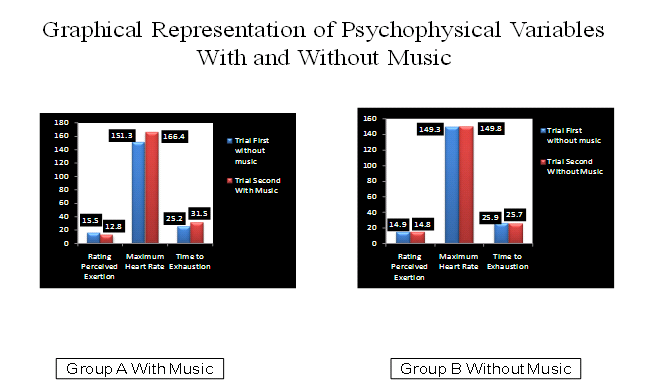
Discussion:
The purpose of this study was to determine the effect of music on University male Physical education Students work output - Rating Perceived Exertion, Maximum Heart Rate, Time to Exhaustion(TTE). The findings indicate that music had Psychophysical effect on the athletes, as measured by RPE, Maximum HR and TTE. Based upon previous research, it was hypothesized that RPE would be lower during sub maximal intensities while listening to music. The findings of this study are congruent with previous research which found RPE to be lower during sub maximal exercise when listening to music had effect on physiological responses to exercise in the present study, as measured by time to exhaustion and maximum heart rate (Boutcher&Trenske 1990; Copeland & Franks, 1991).The finding of this study also congruent with the study conducted (Szmedra&Bacharach,1998; Copeland & Franks, 1991),music positively affected physiological variables in trained & untrained individuals ,including HR,Blood Lactate, Systolic Blood Pressure and Time to Exhaustion. Evidence from this study suggests that music will affect running performance or perception of effort in physical education students. It is also important that further research be conducted to determine how different types & intensities of music affect work output &RPE in physical education students.
The result of this study suggests that physical education teachers & coaches may benefit their students by playing music which in many ways shall depicts the intensity of the upcoming workout as students enter the workout room. In this way, the increase in respiration & moderate increases in heart rate from the music will prepare the students for better the forthcoming workout.
Many health & fitness professionals are currently working with the obese, physically challenged, due to neuromuscular or orthopedic disorders and daily life style. The use of music can be advocated to enhance a persons gait, fitness level, gross motor skills, leading to increased stability &mobility of the clients.
References
Ansel, M.H., and Marisi.D.Q.(1978).Effects of music and rhythm on physical performance. The Research Quarterly,49(2),109-13.
Borg, G.A.V. (1982).Psychological bases of perceived exertion. Medicine and Science in sports and Exercise, 14,337-381.
Boutcher, S. H., & Trenske, M. (1990). The effects of sensory deprivation and music on perceived exertion and affect during exercise. Journal of Sport and Exercise Psychology, 12, 167-176.
Copeland, B. L., & Franks, B. D. (1991). Effects of types and intensities of background music on treadmill endurance. The Journal of Sports Medicine and Physical Fitness, 31, 100-103.
Dainow, E. (1977). Physical effects and motor responses to music. Journal of Research in Music Education, 25, 211-221.
Ellis, D. S., & Brighouse, G. (1952). Effects of music on respiration and heart-rate. The American Journal of Psychology, 65, 39-47.
Karageorghis,I.C.,Priest,D.L.,Terry,P.C.,(2006b).Redesign and initial validation of an assessment of an instrument to assess the motivational qualities of music in exercise:The Brunel Music Rating Inventory-2.Journal of Sports Sciences,24(8)
Potteiger,J.A.,Schroeder,J.M.,Gogg,K.L.(2000).Influence of music on rating of perceived exertion during 20 minutes of moderate intensity exercise.Perceptual and motor Skills,91,848-854.
Priest,D.,Ksrageorghis,C.I.,Sharp,N.C.(2004).The characteristics and effects of motivational music in exercise settings:the possible influence of gender,age,frequency of attendance and time to attendance.Journal of Sports Medicine and Physical Fitness,44,77-86.
Rejeski,W.J.(1985). Perceived exertion: an active or passive process?Journal of sport Psychology,7,371-78.
Reynolda & Gretchen,"Phys Ed: Does music make you Exercise Harder?".The New York times, August 25,2010.
Szmedra,L.,and Bacharach,D.W.(1998).Effects of music on perceived exertion,plasma lactate,norepinephrine and cardiovascular hemodynamics during treadmill running.International journal of Sports Medicine,19(1),32-37.
Tenenbaum,G.,Lidor.R.,Lavayan,N.,Morroww,K.,Tonnel,S., Johnson,M.(2007).The effects of music type on running perseverance and coping with effort sensations.Psychology of sports and Exercise,5,89-109.
Yamashita,S.,Iwai,K.,Akimoto,Kono,I.(2006).Effects of music during exercise on RPE,heart rate and the autonomic nervous system.Journal of Sports Mediciene and Physical Fitness,46(3),425-30.
Ancient Indian Medicine- Gateway To Universal Health
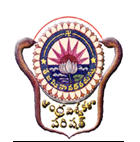
Presented by
Dr. R C REDDY
DEPARTMENT OF PHYSICAL EDUCATION
ANDHRA UNIVERSITY
VISAKHAPATNAM
E-MAIL: drrcreddy72@gmail.com
In this modern stressful world human health has become causality. Both an urbanite and ruralite are finding it very difficult in their respective busy line to pay any serious attention to a sustainable health.
Modern stress and strain is leaving a cancerous impact on men's health. Though longevity of men has increased over the years, yet the quality of life is a big question mark. Of course, in recent time's health awareness and consciousness is on the rise, but what people should achieve is affordable health system.
Even after 63 years of Independence still 37% of Indians are living under below poverty line, of the remaining above poverty line i.e. 95% hail from middle or lower middle class back ground. So for majority of Indians affordable and sustainable health is essential for all-round growth.
We all know that we have made tremendous strides in health care in last few years; it has become prohibitively costly beyond the reach of common man. What is necessary today is affordable and inclusive health care. Inclusive here means, I believe with in the reach of men hailing from the lowest strata from the society.
We have various streams of medical systems namely allopathic, ayurvedic and homeopathic etc., unfortunately research in the ancient medicine of the world has not been considered seriously by this modern society.
Ironically it is simplest, cheapest and easiest of all the systems. It does not require any specialist or any expensive medicine or any kind of diagnostic test or even any use of equipment. It can be easily preached and practiced in every house even by laymen. It is a time tested and proven Medicare test which has yielded a phenomenal result.
How to get good Health?
Health is just not limited to physical fitness but also includes mental
well-being and bliss. Ancient Indian Medicine gave prominence to a sound mind and emotional balance, which can be achieved by meditation and recitation
of certain mantras such as "Gayatri Mantra". I am proud to say that in future modern medical remedies would just not be limited to taking drugs but it
would include ancient Indian medical practices such as ' Yogaasanas, Pranayam, meditation and recitation of mantras'.
Man is destined to rise from mere physical sphere to a broad spiritual sphere. Then man would grow to a superhuman stage. This is not exaggeration but an undisputed fact. Just as man evolutionised from a single cell, he would further evolutionise to a superhuman stage, because of the mind but not the body that would play a key role-not physic but psychic. The whole world would then accept and acknowledge the Indian Theory of Medicine.
Thus anyone desirous of sound health should realize the importance of maintaining the equilibrium of the said three traits, prevent the abnormalities and deficiencies and thereby rise to a super-human stage
Ancient Indian medical expert 'Cheraka' suggested that every human being should expose his/her body to seasonal changes and consume seasonal foods/fruits so as to augment body resistance, which in turn prevents many diseases. How strong and sound the body may be, unless one has mental bliss and purity, one can't enjoy complete sound health. For this, one must practice 'Recitation of sound energy and meditation'. So one must always remember the evergreen dictum' A sound mind in a sound body'
Indian theory of medicine is worth doing maybe tougher to see but is simple and designed to do at home or in open places and are cost free proved to be the highly effective elixir of healthy and happy life which can be afforded by every individual.
Indian theory of medicine not only cures the modern ailments but also prevent terminal illness and it could help you to a longer life and an active independent old age and can certainly delay or avoid the need for institutional care in the old age.
The role of physical exercise:- Physical fitness is the key to long life, fit people make a fit nation. Physical fitness can be defined as" As a capacity to perform sustained muscular work satisfactorily" Fitness of the muscle warrants regular exercise to consume and burn calories which he takes in his food daily. Physical fitness is the richest possession of a man. It has to be earned through a daily routine of physical exercise. A successful person is one who leads a healthy life but not wealthy life. Physical robustness keeps an individual fit active and joyful.Physically strong citizens make their country strong.
A sound mind lives in a strong body.
To preserve health is a moral and religious duty, for health is the basis of all social virtues. Health is goodness Weakness is Sin.
It is needless to say that physical exercise plays no mean role in the upkeep of health. It may be repeatedly emphasized walking, jogging, swimming, cycling etc keep one's body fit and trim. An apple a day keeps the doctor away should be modified to walk a mile a day keep the doctor away. 'Walk a mile---Keep your smile' is the simple secret of health.
Million rupees…Billion Problems
Thousand steps………Billion Smiles
'Run for your life' is the order of the day. "So be on your legs as long as possible or else four pair of legs may carry you on your premature last Journey"
Balanced diet is another key factor. 'Eat greens and be evergreen' is the latest law of life. They say that you are what you eat and what you do'
So fitness wellbeing and health are good friends. Where one is, the other two will be
FITNESS WELLBEING AND HEALTH
There is an age-old dictum 'Health is real wealth'. It is needless to say that health is intricately connected to fitness and well-being. In fact, they are complimentary- the vehicle of health vests on the two wheels of 'Fitness and Well-being'
Right from birth to death the only true aim of everyman for that matter, of every living-being is-;To live longer, better and healthier'. And above all a life free from sickness and diseases every moment of life, man strives to breathe easy and feel good.
Human body is a complex machine. Its miraculous working depends on fitness, well-being and health. Like any other machine, our body machine needs constant exercise. "To rest is to rust' is a no mean remark and it finds a universal acceptance.
Well-being and Health is an offshoot of constant exercise. Modern man leads mostly a sedentary life eating junk food and wholly relying on automobiles to ply from home to work place and back. There is hardly any scope for time for physical activity, leading to obesity and other related ailments such as diabetes, Hypertension and consequential cardio vascular diseases. Most of the human beings they sacrifice their first half of life for earning wealth at the cost of health. The Second half of life they sacrifice the earned wealth to protect health. Ultimately they left with nothing. Either they will have health or wealth.
"Prevention is better than cure" truly applies to well-being and Health. The best way to cure is to prevent. I consider that regular exercise is insurance to health and in prevention of hypo kinetic diseases.
To trace the history of medical science, Lord Brahma bequeathed it to Prajapati, who in turn passed it over to Aswini Gods, and then to ancient rishis and scholars.
Health may be defined as a proportionate balance of Phlegm, Bile and Gastro traits in human body. "Doshanaam Saamyamarogyam Vaishaamyam Vyadhi Rubhyate"- According to Ayurveda any imbalance of aforesaid traits is the root cause of disease. Only a yogi can maintain this fine balance of traits through yogakriyas.
Death is inevitable and predestined and so no one can escape from the icy pangs of death. But one can prolong one's life by certain medical and medicinal remedies. Fitness is nothing but maintaining a fine balance of Phlegm, Bile and Gastro traits. It is also necessary to maintain the levels of seven important aspects such as muscle 'main bones, bone marrow, sperm, veins, blood and nerves etc.
The abdominal part of human body plays a key role in maintaining health. So certain aasanas such as 'Bhujagaasana,Mayuraasana' Dhanurasana, Paschimottanasana, arthamatsyendrasana and Halasana. Activate the abdominal muscles and veins, which in turn maintain body health.
Nearly seventy two thousand veins originate from navalpit and spread all over the body. Of these, three are most important-'Ida, Pingala and Sushuma'. The first two are situated in the nostrils and they can be activated by performing regular 'Pranayama' The last named is a cosmic vein and if it is activated, one can enjoy sound health, Yogic climax and bliss. Different kind of aasanas activate different veins, muscles and secretions in human body, resulting in eternal sound health.
Regular Pranayama helps in oxygenisation i.e., optimum utilization of inhaled oxygen, which supplies vital energy to the body. It leads to both physical and mental bliss and keeps human body battle-fit forever. Thus maintaining different body traits is the secret of fitness and health.
Health and wellness promotion includes efforts to alter personal lifestyles to enhance the quality of life, just as physical fitness is altered by regular physical activity; wellness is a state of being that is altered by ones behavior that is partially or totally in one's own control. That includes 8 limbs of Astangayoga. These are 1.Yama (Restraints) 2.Niyama (Observance) 3. Asana (Postures) 4. Pranayama (Control and expansion of breath) 5. Pratyahara (Interiorization of mind) 6. Dharana (Concentration) 7. Dhyana (Meditation) 8. Samadhi (Divine union). Some of the healthy life styles considered to be very important to optimal wellness are as follows: "Exercising regularly, eating properly, managing streets, avoiding destructive habits, participating safe sex, adopting good safety habits, learning first aid, adopting good personal health behavior, seeking and complying with medical advice, being an informed consumer, protecting the environment, and managing time effectively.
Exercise regularly:
The food we eat has to be digested and absorbed for which the body machine requires constant exercise to burn the calories, without regular exercise our body becomes redundant. Exercise doesn't mean going to gym and do acrobatics. Simple walking or jogging would do, 'Walk a mile….Keep your smile'
Eating promptly:
We are….. What we eat. Modern junk food is nothing but slow poison. Our diet should be a balanced one. Limited carbohydrate and oils, plenty of vegetables, fruits and fibrous food, adequate clean water should be taken from time to time. Always make it a point to take heavy breakfast, moderate lunch and light dinner. 'Eat to live but not live to eat' should be the motto.
Avoiding destructive habits:
All the good work done by regular exercise and balanced diet is negated by vicious habits such as cigar, Beedi, Cigarette smoking, Jarda, Kaini, Panparag, boozing etc,
Cigarette smoking adverse effects on Human performance
1. Cigarette smoking increases the density of lungs
2. Decreases lung defusing capacity.
3. Decreases lung ventilation.
4. Decreases oxygen absorbing capacity.
5. Increases Heart rate and decreases stroke volume.
6. Decreases hand eye coordination.
7. Even for smaller work load also greater oxygen debt.
8. Cigarette smokers are more prone for heart deceases, lung cancer and T.B. (Tuberculosis)
9. A cigarette reduces approximately 1 to 3 minutes of our most valuable life, where as diabetics looses 5 to 8 minutes.
10. Long standing cigarette smoking further facilitates flaring up of the pre existing conditions of men.
11. Even passive smoking is harmful.
Adverse effect of Jarda, Kaini and Panpaarag Habits:
1. Leads to mouth ulcers and mouth cancers particularly lung palet and gums.
2. Throat cancer
3. Esophagus (food pipe) cancer
4. Stomach ulcers and cancer
Alcohol adverse effects
(a) Leads to gastritis (stomach ulcers and burning sensation)
(b) Liver cirrhosis (shrinkage of liver) liver cells are death and become fibrosis (fibrosis is nothing but scar tissue)
(c) Alcohol increases the diverse glomororal filterization of kidneys.
(d) People are advised to take medicated dose of alcohol may be 30 ML
(e) If intake increases they lost their inhibition.
(f) If intake further increases it affects the central nervous system and become unconsciousness.
So keep a distance from these Destructive habits:
Managing stress:
In the present modern world, stress accounts for a majority of slow-killing diseases such as Hypertension, Diabetes etc., the best way to prevent the ill-effects of stress is to relax and meditate daily for half an hour. Certain asanas also help in relieving stress. A good night's sleep is the best way to release stress.
Participating in safe sex:
Single sexual partner i.e., our life partner is an insurance to longevity of life. Multiple sexual partners is a free ticket to AIDS. Use of Immune contraceptives for safe Sex. The use of condom is the best way to practice safe sex. Use good quality condoms and indulge in abstinence from time to time.
Adopting good safety habits:
Personal habits and hygiene is the gateway to longevity and sound health. Early to bed and early to rise, periodical balanced diet, keeping away from smoking and boozing , keeping one's body and surroundings clean…. are some of the tips to maintain sound health.
Learning First Aid:
A wise man is one who has working knowledge of First Aid. For example how one should react during accidents, bleeding injuries cuts and burns, during heart attacks etc. Keeping a first aid box at hand is always advisable. It is the first that saves many lives during emergency. First aid is the thin line that saves life from death.
Seeking and complying with medical advice:
A health-conscious person should first know his physiology…ie., body behaviour. What his body likes and dislikes… what is reactive and resistant to his body. Getting periodical medical check-up and complying with the doctor's advice after forty is a must.
Being an informed consumer:
We are living in world of consumerism and market forces strongly influence our needs. So it is essential for us to be aware of the rights and responsibilities of a true consumer. An alert and watchful consumer would keep the market forces at bay. Unethical trade practices. Adulteration, tax evasion can be controlled if the consumer is aware and alive to 'the ticks of the trade'.
Protecting the Environment:
Survival of man depends on the survival of plants and animals-preserve our national heritage for safer and secure tomorrow, safeguarding environment is everybody's concern. Development must be environmentally sound and sustainable, socially desirable, economically viable and ecologically sustainable. Environment plays a key role in our lives. 'Live and let live' should be the motto of our life. Restricting the emission of Green house gases, sewage-water treatment, controlling sound, water, air and plastic pollution etc. We must adopt environmental-friendly methods such as grow more trees for the Purposes of one should maintain the ecological balance, to maintain the life support systems. Trees are considered to be the lungs of the world, directly indirectly for the welfare of the mankind. Besides being effective regulators of environmental protection.
A fifty year aged tree provides benefits approximately to the tune of 16 lakhs rupees worth in serving the mankind Oxygen production -2.5 lakhs
- Pollution Control - 4 Lakhs
- Soil Conservation - 2.5 Lakhs
- Water Conservation - 2.5 Lakhs
- Timber, fuel & Proteins - 0.5 Lakhs
- Shelter to Animals - 2 Lakhs
- Ozone Protection - 0.5 Lakhs
- Climate Regulation - 0.5 Lakhs
- Tope Soil Preservation -0.5Lakhs
- Preventing Global warning -0.5 Lakhs
Managing Time efficiently:
If there is something in this world which can never be regained is the lost time. 'If wealth is lost, nothing is lost….. if health is lost, something is lost, but if time is lost…everything is lost. So manage time efficiently. 'Make haste with leisure and fill every moment of your life with utility and bliss'
The study is designed to find out the effect of yogasana, pranayama, meditation, rectitation of mantras on body weight, resting pulse rate, systolic blood pressure, diastolic blood pressure and blood sugar.
To achieve the purpose of the study 125 Females 30-40 years of age group having health problems such as obesity, pulse rate disorder, hypertension and diabetes millets were selected from yoga training centers and nature cure hospitals of Andhra Pradesh. This topic based on not just theoretical preparations but practical observations and conclusions
The recommended exercise program is 15 to 20 minutes of brisk walk followed by 10 yogasans, one kriya and four pranayamas
The exercise program is 6 weeks. Statistical data has been presented supported by bar diagrams for weight, resting pulse rates, blood pressure by systolic and diastolic and blood sugar levels clearly indicates the spectacular result after the exercise program .
Hence an appeal to Government Authorities and agencies and also various NGOs and Corporate Houses to inculcate the awareness of making extensive use of Indian theory of medicine particularly in villages where modern Medicare yet to reach.
If the Government of India priorities the systems in the forth coming 12th plan period, there is no reason why the Indian would become "Healthy Nation by 2020" if not earlier. I could also appeal to the intellectuals' scholars' .Academicians and planners to prevail upon the authorities concern to the necessary steps on a war footing to popularize Indian theory of medicine.
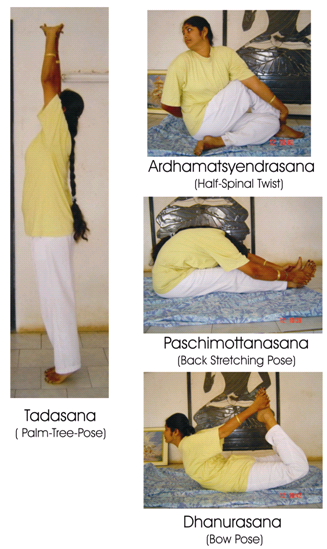
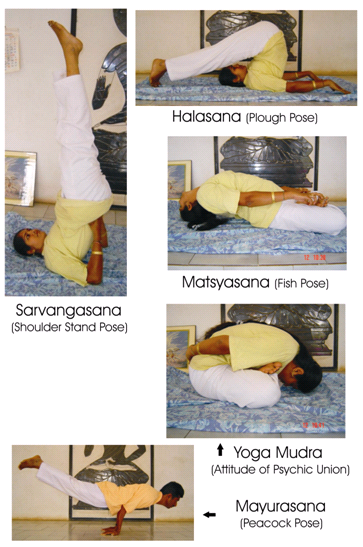 .
.
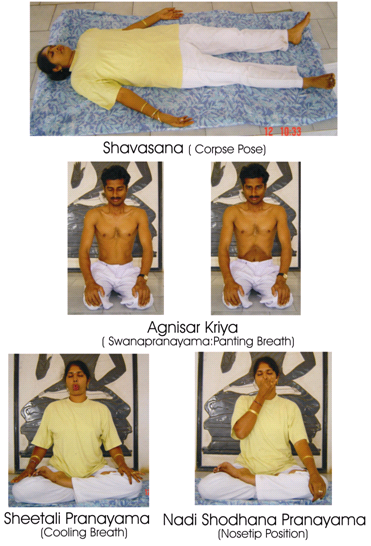
Tab: Mean values of Experimental Pre-Test & Post Test groups on Body Weight, Resting Pulse Rate, Systolic Blood Pressure, Diastolic Blood
Pressure and Blood sugar in the age group 30-35 Years.
|
Parameter |
Group |
Sample Size |
Mean |
Std. Deviation |
Std. Error |
P. Statistic |
P. value |
|
Weight |
Experimental Pre-Test Experimental Post-Test |
9 9 |
74.66 70.00 |
4.15 4.39 |
1.38 1.46 |
10.6 |
S |
|
Resting Pulse Rate |
Experimental Pre-Test Experimental Post-Test |
9 9 |
75.33 72.11 |
1.87 0.93 |
0.62 0.31 |
5.03 |
S |
|
Systolic Blood Pressure |
Experimental Pre-Test Experimental Post-Test |
9 9 |
166.67 125.00 |
4.33 2.50 |
1.44 0.83 |
28.9 |
S |
|
Diastolic Blood Pressure |
Experimental Pre-Test Experimental Post-Test |
9 9 |
104.44 88.33 |
6.35 5.59 |
2.12 1.86 |
5.63 |
S |
|
Blood Sugar |
Experimental Pre-Test Experimental Post-Test |
9 9 |
260.67 181.44 |
15.79 6.48 |
5.26 2.16 |
16.80 |
S |
Fig: Mean values of Experimental Pre-Test & Post Test groups on Body Weight, Resting Pulse Rate, Systolic Blood Pressure, Diastolic Blood Pressure and Blood sugar in the age group 30-35 Years.
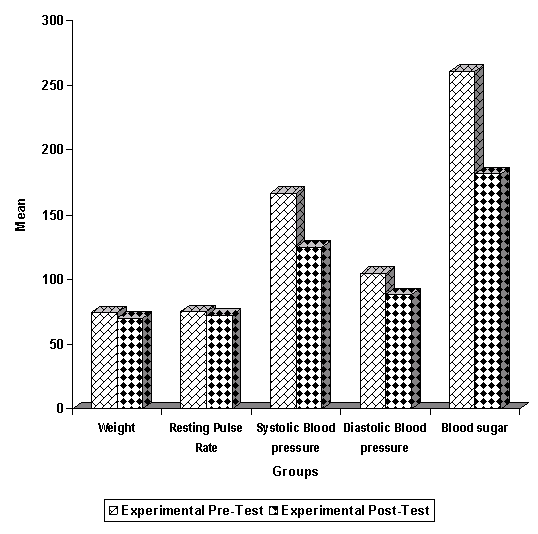
Tab: Mean values of Experimental Pre-Test & Post Test groups on Body Weight, Resting Pulse Rate, Systolic Blood Pressure, Diastolic Blood Pressure and Blood sugar in the age group 36-40 Years.
|
Parameter |
Group |
Sample Size |
Mean |
Std. Deviation |
Std. Error |
P. Statistic |
P. value |
|
Weight |
Experimental Pre-Test Experimental Post-Test |
21 21 |
75.62 70.76 |
3.78 4.95 |
0.82 1.08 |
8.58 |
S |
|
Resting Pulse Rate |
Experimental Pre-Test Experimental Post-Test |
21 21 |
75.81 72.09 |
1.91 0.83 |
0.42 0.18 |
7.92 |
S |
|
Systolic Blood Pressure |
Experimental Pre-Test Experimental Post-Test |
21 21 |
172.62 127.14 |
6.05 5.61 |
1.32 1.22 |
27.00 |
S |
|
Diastolic Blood Pressure |
Experimental Pre-Test Experimental Post-Test |
21 21 |
106.67 88.09 |
6.95 4.02 |
1.52 0.88 |
12.06 |
S |
|
Blood Sugar |
Experimental Pre-Test Experimental Post-Test |
21 21 |
182.14 151.67 |
4.92 18.78 |
1.07 4.97 |
17.3 |
S |
Fig : Mean values of Experimental Pre-Test & Post Test groups on Body Weight, Resting Pulse Rate, Systolic Blood Pressure, Diastolic Blood Pressure and Blood sugar in the age group 36-40 Years.
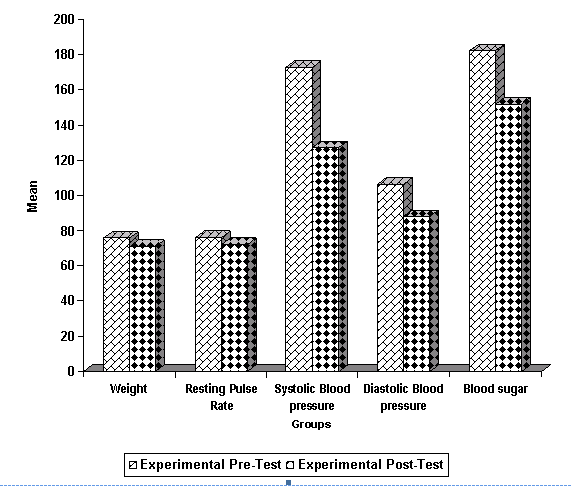
" NUTRIENT INTAKE AND DIETARY PATTERN OF HOCKEY PLAYERS OF HEMCHANDRACHARYA NORTH GUJARAT UNIVERSITY PATAN"
Dr. Nagin H. Gamit
Shri&Smt.P.k.kotawala Arts college, Patan. (N.Guj)
University, Patan. (India.) Pin — 384265
ABSTRACT
The present study was taken up with two groups i.e. non-sports university/college and university sports Department, Hockey players. A total of 120 male Hockey players. age groups between 18-22 years and 23-28 years were selected from the colleges of the university , 60 players from each city of .Patan, Banashkatha,Sabarkatha and Mahesana District by using stratified random sampling techniques. Nutrient intake was determined by 24 hours dietary recall method. The average nutrients intake was calculated. Maximum players in non-sports university/college followed four meals pattern, whereas in university sports Department maximum players followed five meals pattern. Mean nutrient intake of non-sports university/college Hockey Players shows that caloric, protein and iron intake were less than recommended dietary allowances. However fat, calcium, vitamin A, Vitamin C, thiamine and riboflavin. The mean nutrients intake of university sports Department players were in accordance with recommended dietary allowances.
INTRODUCTION
Hockey is probably the world's most popular sports, played in every nation at varying level of competence. Nutrition playes a vital role in the health of players . The food intake of Hockey players was based on cereals, meat, fish , eggs, milk and dairy products, biscuits and confectionery, oil, butter and margarine which provided 78 percent of total energy, 85 percent of proteins, 64 percent of carbohydrates, 90 percent of lipids, and 47 percent of fiber. The sufficient iron, 48 percent of individuals showed iron deficiency without anemia (Reilly 1996). A healthy diet improves the general level of health and can help to recover more quickly from injuries. Along with a programmer of fitness training, the diet can help to develop stamina and improve players' performance. The nutritional needs of Hockey players are usually greater than the normal male, It was suggested that they should take approximately 70 Kcal/kg energy of the ideal body weight, protein up 60 g/day, fat 25g/day is good for sportsmen (Murphy et.al.2006). Due to exclusive physical stress and vitality need of micronutrients such as vitamins and minerals is exceeded. For good stamina and vigor's needs of B complex, vitamin A, vitamin C and vitamin E is also increased, like wise calcium, phosphorous, iron and magnesium minerals sources should be added into the daily diet (Sheriffs et.al.2005). Ellen et al.(2000) suggested that sportsmen must eat the "perfect ratio" consists of 40 percent carbohydrates, 30 percent protein and 30 percent fat. Each meal and snack should provide 12-15 percent total calories from protein at least 55-60 percent from carbohydrate and up to 25-30 percent to control their hormonal system and thus reach their maximum performance and ideal body weight, youth participating in sports should eat a variety of food from breads and cereals, fruits, vegetables, meat and meat substitutes and dairy food. Foods rich in simple sugar and fatty acids like tobacco, caffeine, sugar and refined spicy food should be avoided (Srilakshmi 2000). The fluid and nutrient needs during a contest / game depends on the intensity duration, ambient temperature and humidity. The sports person cannot depend on thirst to meet fluid needs : the sports person should drink 400 to 500 ml water two hours before the competition. They should drink 100 to 150 ml every 20 minutes depending on the event and climate and should continue to drink fluids after the event until the lost weight is restored. Plain cold water if normally the fluid of choice to ensure dehydration except for endurance competitions or training rounds (susan et.al.2006). In sports, the macronutrients and carbohydrate plays an important role as fuel to the body during sports activities. When the level of carbohydrate is reduced intensity and length of activity decreases and fatigue rapidly increases. Any of this may be detrimental to optimal sports performance (Hawley et.al.2006) keeping this view in mind the present study was taken up with following objective to study the dietary pattern and nutrient intake of Hockey players.
METHODS :
Selection of sample: three stages of sampling was adopted for the present study
stage I : selection of city stage II : selection of area. Stage III : selection respondents.
Selection of City : The colleagues of Patan, Banashkatha, Sabarkatha and Mahesana District of North Gujarat were selected for the investigation because its accessibility and regular visits that could make this study easy and approachable The selections of these cities were made purposively because of availability of Hockey players.
Selection of Area : A university and a college was selected for procuring desired data, they are : Hemchandracharya North Gujarat University, Patan and University Sports Department, Patan.
Selection Of Respondents : Total 120 male Hockey players were selected between the ages of 18 to 28 years. Stratified random sampling techniques were used for the selection of respondents. 60 respondents from Patan, Banashkatha,Sabarkatha and Mahesana District 60 respondents form Mahesana cities were selected 30 respondents of each age group i.e.18-22 and 23-28 years randomly selected respectively. They were participating in Hockey competitive matches at college / university levels.
Collection of Data : A checklist type of questionnaire was selected, as it is reliable method to elicit information and dietary pattern of Hockey players . The questionnaire helped to elicit the following information regarding food habits and nutrient intake etc.
Assessement of Nutrient Intake : 24 hours dietary recalls method was adopted and nutrients intake per day was calculated ( Swaminathan,2004). Calculation of nutrients intake was done with the help of the nutritive value of Indian foods and compare with RDA given by ICMR (Gopalan et at.2004).
Statistical Analysis : The collected data were analyzed with the help of following tests as per the procedure of Fisher and Yates presented by Arrora et.al (2007)
FINDINGS : TABEL-1
DIETARY PATTERNS OF THE HOCKEY PLAYERS
|
DIETARY PATTERN |
NON-SPORTS UNIVERSITY/ COLLEGE |
UNIVERSITY SPORTS DEPARTMENT |
AVERAGE |
|||
|
n=60 |
% |
n=60 |
% |
n=120 |
% |
|
|
4 meal pattern * |
39 |
65.00 |
19 |
31.66 |
58 |
48.33 |
|
5 meal pattern** |
21 |
35.00 |
41 |
68.33 |
62 |
51.66 |
|
Total |
60 |
100 |
60 |
100 |
120 |
100 |
* = Breakfast + Lunch +Evening tea + Dinner
* *= Breakfast + Lunch +Evening tea + Dinner +Any other
TABLE II
AVERGE NUTRIENT INTAKE OF HOCKEY PLAYERS
|
NUTEIENTS |
RDA |
UNIVERSITY SPORTS DEPARTMENT |
NON SPORTS COLLEGE |
|
Energy (keal) |
3800 |
3980.5 |
3425.92 |
|
Protein (G) |
60 |
70.9 |
56.0 |
|
Fat (G) |
20 |
25 |
25 |
|
Iron (mg) |
28 |
23.9 |
26 |
|
Calcium (mg) |
400 |
540.5 |
510.7 |
|
Vitamin A (micro g) |
2400 |
2450 |
2510 |
|
Vitamin C(mg) |
40 |
60.78 |
45.7 |
|
Vitamin B1(mg) |
1.6 |
2.3 |
1.8 |
|
Vitamin B2 (mg) |
1.9 |
3.45 |
2.5 |
DISCUSSIONS OF THE FINDINGS :
DIETARY PATTERNS OF THE HOCKEY PLAYERS
Table-I shows that majority of Hockey players, 51.66 percent followed five meals pattern.whereas 48.33 percent Hockey players were following four meals patterns. Among non- sports university / college Hockey players 65 percent were taking four meals pattern and 35 percent Hockey players were taking five meals pattern. Similar results were observed by Serrotosa (2001) also found out that majority of the Hockey players took four meals per day. However, among university sports Department maximum numbers of Hockey players (68.33 percent) were taking five meals pattern. , rests 31.66 percent of Hockey players from university sports Department were taking four meals pattern. Most of the Hockey players form university sports Department got economical supports from the college and followed the diet recommended by the dietician there fore, they used to follow five meals pattern per day whereas, the Hockey players form non-sports university/college does not have any economical support none of the college and were not aware of the importance of regular meal pattern so they generally followed four meals pattern.
AVERAGE DAILY ENERGY AND NUTRIENT INTAKE OF THE HOCKEY PLAYERS.
Table-II shows the daily nutrient intake of Hockey players from non-sports university/college and university sports Department with reference to calorie, protein,fat,iron, calcium,vitamin C, vitamin A,thiamine,riboflavin and vitaminn B12 were comparing with RDA (Gopalan,C.2004) Among non-sports university/college players the mean daily nutrient intake of caloric, protein, iron was less than RDA whereas, the mean of fat, calcium, vitamin C, thiamine, riboflavin and vitamin B12 was more than RDA. Mean nutrient intake of university sports Department Hockey players iron was less than RDA. whereas, the Mean intakes of calories, protein fat, calcium,vitamin A, vitamin C, thiamine, riboflavin, and vitamin B12 were more than RDA. The results reveal that the nutritional status of university sports Department Hockey players was batter than non-sports university/college Hockey players. This may be due to the intake of planned diet advised by dietician along with nutritional and economical support provided by the college to university sports Department Hockey players, which may enhance their vital abilities to perfrom better. On applying 't'-test on the difference between nutrient intakes of Hockey players from both groups a significant difference was found. Jillian K.et.al.(2006) suggested adolescents participating in sports have better eating habits and nutrient intake than that of their non-sport adolescent players. However, they are still in need of nutrient interventions particularly in calcium intake.
CONCLUSION :
Among players of non-sports university/college, majority of the players (65 percent) were taking four meals per day however, among university sports Department maximum numbers of players (68.33 percent) were taking five meals per day. Daily consumption of cereals, pulses, fats and oils, sugar and juggory was in accordance with the RDA where as the daily consumption of green leafy vegetables, fruits, meat and fish were less than the RDA in both the groups. In non-sports university/college players the mean nutrient intake of calories, protein and iron was less than recommended dietary allowances (RDA) whereas, mean intakes of fat. calcium, vitamin C, vitamin A, thiamine, riboflavin and vitamin B12 were more than the RDA. while mean nutrient intake of university sports Department players was in accordance with RDA except iron intake, which was less than the RDA, on applying t-test there was a significant difference found between both the groups. 50 percent and 53.33 percent of players were taking plain water in both the groups for compensating the loss through perspiration. It is concluded that mean nutrient intake of non-sports university/college Hockey players was less then recommended dietary allowance (RDA) but in university sports Department Hockey was in accordance with RDA.
REFERENCES:
Arrora.s, Arrora.P , And Arrora.P.N.1st Edition. Comprehensive statistical methods. S.chand publications : 7.1-7.4,17.1-17.71,18.1-18.28.Ellen, Krause "Nutrition and Diet therapy' Agra publication 2000.742-746 Murph,Sue,Jeanesy and Vonne " nutritional knowledge and dietary intakes of young professional Hockey players." Nutrition and food science 2006 May : 36:343- 348.
Really " Science and Hockey" Essential and FN spun London 1996.P-164-171.
Shirreffs. M.S Hall.M. "Physiological profile in relation to playing position of elite college garlic Hockey" British Journals of Sports medicine 2005 May : 39:264-266.
Thank you
COMMON SKIN INFECTIONS AMONG SPORTS MEN -A SURVEY.
B.S.Anuradha * & P.RaviKumar**
* Department of Microbiology Chaitanya Post graduate College Hanamkonda 506001
** Department of Physical Education National Institute of Technology Warangal 506004
INTRODUCTION
Almost any cutaneous infection can afflict athletes; however, their activities place these individuals at higher risk to develop and subsequently transmit their skin ailment to competitors. Athletes acquire infections as a result of their interaction with other athletes and with the environment in which they compete. An athlete's skin is often macerated from sweating which provides a fertile environment for microorganisms. Furthermore, trauma inherent to sporting activities can create a disturbance in the cutaneous barrier which allows the microorganism to penetrate. Lastly, many sports involve close skin-to-skin contact which facilitates the spread of infectious organisms within and among teams. . The most common infections in sports include bacterial, fungal, and viral infections, but parasites can also afflict the athlete, ( Brian B. Adams ,2008).
Athletic participation has increased in popularity in the past several decades. Infectious conditions exemplify the most common cutaneous ailments of athletes. Once infected, athletes may endure loss of practice time and disqualification from competition. Rapid diagnosis, appropriate institution of therapy and attentive prevention programs all minimize the deleterious effects of skin infections for both the athlete and the team. (Adams,2010).
Skin infections account for up to 10% of time-loss injuries in some sports and can cause serious illness. Skin infections can be spread from one athlete to another. We can help protect athletes from becoming sick or losing playing time due to skin infections.
Multiple skin infections in the athlete exist. Fungi, bacteria and viruses cause the majority of sports-related skin infections. Most common skin infections in sports men are Bacterial: Staphylococcal skin infection, Fungal: Dermatophycoses (Ring worm), Viral: Molluscum contagiosum, Herpes simplex, Verruca and Flat worms etc. Several distinct differences in skin infections exist between athletes and nonathletes. (Adams BB, 2006). First, athletes experience a significantly higher prevalence of these infections. As a result of intense skin-to-skin contact, rampant sharing of equipment, occlusive clothing, open wounds and profuse sweating athletes develop and transmit microorganisms at alarming rates. Cutaneous infections cause disruption to an athlete's exercise program by causing discomfort, isolation and disqualification. The basic knowledge about these infections is very important for preventing these infections and also from transmitting them to other players.
Skin infections can lead to:
- Loss of playing time
- Scarring, sometimes on face
- Wounds or rashes that keep recurring
- Rarely, serious life-threatening infections if not treated quickly
This article will discuss the epidemiology, clinical presentation, complications, treatment and prevention of the aforementioned infections in athletes.
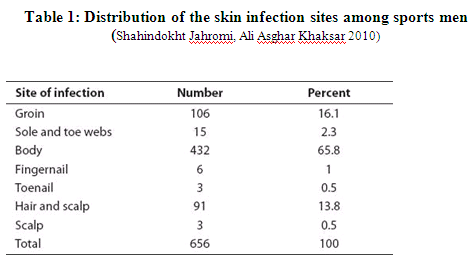
Bacterial infections:
Several specific sports-related dermatologic conditions are caused by bacterial infection.(Figure 1). Staphylococcal infection is the most common .(Freeman MJ, Bergfeld WF, 1977, Bergfeld WF, Taylor JS 1985, Sosin DM, Gunn RA, Ford WL, et al ,1989, Powell FC,1994). It causes infections such as impetigo, erysipelas, folliculites,(Freeman MJ,Bergfeld WF,1977, Bergfeld WF, Taylor JS 1985) and furunculosis(Sosin DM, Gunn RA, Ford WL, et al ,1989).These bacterial infections occur in athletes participating in sports in which close personal contact occurs, including rugby, judo, and wrestling. (Brain Adams, 2008) Fomites (bags,mats,balls,bats,towels etc.) also help in transmission of these infections.
Treatment:
Pustules can be treated with topical or oral antibiotics. Isolation of the athlete from others is important to prevent spread of the disease.
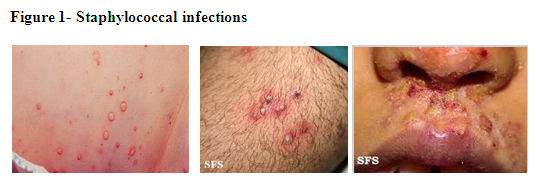
Viral skin infections:
Three main viral infections that affect athletes are Verruca (warts), molluscum contagiosum, and herpes simplex.
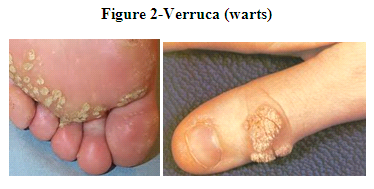
Treatment:
Destroying Verruca will help to prevent it from growing and possibly causing pain. It also aids in preventing it from spreading. Athletes with Verruca should wear sandals while showering in shared facilities.
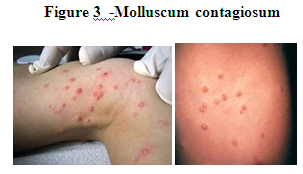
Treatment:
Isolation of athletes with infection. The infections should be treated at the earliest by administering anti viral compounds.
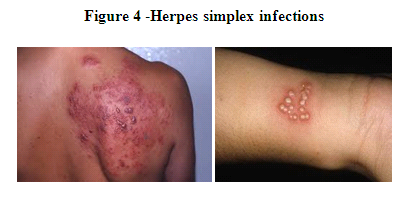
Herpes simplex infection ,(figure 4) known as herpes gladiatorum identified in wrestlers, has been reviewed extensively. ( Freeman MJ, Bergfeld WF.1977, Bergfeld WF, Taylor JS.1985 Sosin DM, Gunn RA, Ford WL, et al,1989, . Powell FC.1944, Becker TM 1988, Kodsi R, Bailey P, et al.1998, Becker TM 1992) Herpes simplex infection may also occur in rugby players also.( White WB, Grant-Kels JM 1984) The clinical presentation is that of vesicles on reddish patch on skin. Rupture of these vesicles may result in erosions. Transmission is primarily through skin-to-skin contact.
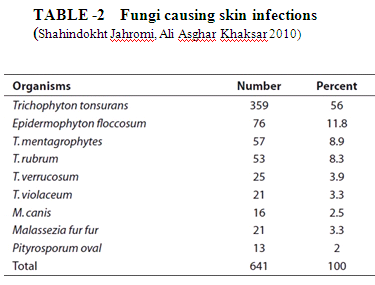 -
-
Herpes simplex infections
Treatment:
Identifying infected athletes promptly and excluding them from direct contact with other wrestlers help to halt these infections. Rapid administration of antiviral treatment may accelerate an athlete's return to wrestling.
Fungal infections:
Also known as Dermatophytes, Dermatomycosis, and Ring worm fungi. The common fungal infections are athlete's foot and Jock itch. Athlete's foot or Tinea pedis is commonly seen in runners, skaters, long distant runners, walkers etc.These infections can occur in both hot and cold climates.There are many number of fungi which can cause these infections as seen in table 2.
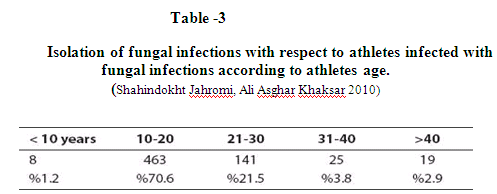
Tinea pedis (figure 5) mostly occurs in the inter digits of fingers. These are transmitted by direct contact and by fomites especially shoes. Tinea pedis can affect many athletes because the causative organism thrives in warm and moist environments.
Treatment:
Affected athletes should be treated with antifungal agents and also wear protective footwear while using shared facilities to decrease transmission to other athletes.
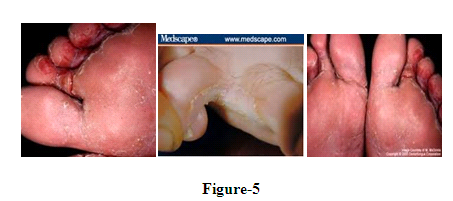
Tinea corporis (figure 6) or Jock itch, dhobi's itch mostly occurs on head, skin and nails. The clinical appearance of tinea corporis gladiatorum varies with the age of the lesion. Mature lesions appear as annular, erythematous, scaling plaques. Mostly seen in wrestlers. Wrestling mats play a large role in transmission.( Vandenesch F, Naimi T, Enright MC et al.2003, Baba T, Takeuchi F, Kuroda M et al 2004)
Treatment:
Athletes, particularly wrestlers and others subjected to extensive skin-to-skin contact should be examined carefully before each practice and competition. Athletes with signs of tinea infection should be treated promptly with antifungal agents and should be removed from direct contact with other wrestlers if the infected area cannot be appropriately covered using bandaging techniques.
Figure 6- Jock itch
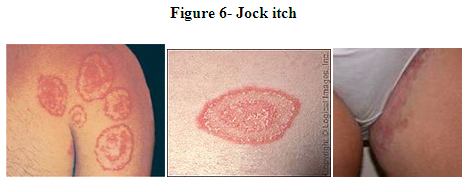
Flat worms:
Flat worms mostly cause a infection known as Swimmers itch. Swimmer's itch (figure 8), also known as lake itch,duck itch, cercarial dermatitis, caused by water borne schistosomes. Symptoms, which include itchy, raised papules, commonly occur within hours of infection and do not generally last more than a week.
Treatment:
Orally administered hydroxyzine, an antihistamine, is sometimes prescribed to treat swimmer's itch and similar dermal allergic reactions.
Prevent the spread of infections
Athlete's responsibilities: |
Coaches, Officials, and Team Leaders responsibilities: |
|
|
CONCLUSION
The basic know how about these infections are very important to coaches, managers, and athletes as well. Good hygienic practices should be followed to prevent these infections. Athletes should limit the amount of exposed skin. Fortunately, fabric technology has advanced considerably and athletes can wear long-sleeved clothing that places a barrier between them and their competitors, absorbs the moisture and sweat, and still allows the athlete to regulate their temperature. Infected athletes must meticulously cover their injured skin. During periods of low prevalence of infections in the team and only during practice, trainers may use bandaging techniques on the infected athlete; bandaging alone does not allow one to compete If the infection is severe the athlete should not participate in the event. No athlete should share towels, pads, clothing, razors or protective headgear. After practice and competition, although no supportive evidence exists, athletes should take showers with antibacterial soaps. Furthermore, all clothing and undergarments require daily laundering.
Athletes represent a unique population who acquire skin infections more often than nonathletes. The rapid diagnosis and treatment of these skin infections will prevent disruption to individual training and competition and will minimize epidemics among teams. Frequent, precise and candid communication among the athletes, coaches and medical staff maximizes the potential for a competitive season free from skin infection. Following good hygienic practices is a key element in controlling these skin infections.
REFERENCES:
Adams BB. (2006) Sports Dermatology. Springer, NY, USA .Exhaustive review of cutaneous lesions in athletes.
Baba T, Takeuchi F, Kuroda M et al.,(2002) Genome and virulence determinants of high virulence community-acquired MRSA. Lancet 359, 1819-1827).
Becker TM, Kodsi R, Bailey P, et al.(1988), Grappling with herpes: herpes gladiatorum. Am J Sports Med;16: 665-669.
Becker TM(1992). Herpes gladiatorum: a growing problem in sports medicine. Cutis 50: 150-152.
Belongia EA, Goodman JL, Holland EJ, et al.,(1991) An outbreak of herpes gladiatorum at a high-school wrestling camp. N Engl J Med;325: 906-910: 906-910. Bergfeld WF, Taylor JS. (1985). Trauma, sports, and the skin. Am J Ind Med;8: 403-413.
Brian B. Adams, MD, MPH (2008) ,Dermatology Nursing. 20(1):39-44. © 2008 Jannetti Publications, Inc.
Shahindokht Bassiri-Jahromi , Ali Asghar Khaksar (2010) Prevalence of cutaneous fungal infections among sports-active individuals . 2010, 3: 2 : 53-57. |
Freeman MJ, Bergfeld WF(1977). Skin diseases of football and wrestling participants. Cutis ;20: 333-341.
Powell FC.(1994). Sports dermatology. J Eur Acad Dermatol Venereol 3: 1-15.
Sosin DM, Gunn RA, Ford WL, et al.,(1989). An outbreak of furunculosis among high school athletes. Am J Sports Med 17: 828-832.
White WB, Grant-Kels JM.(1984) Transmission of herpes simplex virus type 1 infection in rugby players. JAMA;252: 533-535.
Skin diseases of football and wrestling participants. Cutis. 1977 Sep; 20(3):333-41.
ReviewHerpes gladiatorum: a growing problem in sports medicine. Cutis. 1992 Aug; 50(2):150-2.
Transmission of herpes simplex virus type 1 infection in rugby players. JAMA. 1984 Jul 27; 252(4):533-5.
Vandenesch F, Naimi T, Enright MC et al. Community-acquired methicillin-resistant Staphylococcus aureus carrying Panton-Valentine leukocidin genes: worldwide emergence. Emerg. Infect. Dis. 9, 978-984 (2003).
PERIODICAL ASSESSMENT FOR TWO-YEAR OF SYSTEMATIC HOCKEY ACADEMY TRAINING PROGRAM ON AEROBIC CAPACITY
* Mrs. V. HYMAVATHI and **Dr. P. JOHNSON
* Research Scholar & **Assistant Professor,
University College of Physical Education & Sports Sciences,
Acharya Nagarjuna University, Guntur, Andhra Pradesh, India.
Abstract
The purpose of this study was to examine the effect of an entire season of systematic hockey academy training program for two years on aerobic capacity. For this purpose, a total of twenty three boys from RDT Hockey Academy, Anantapur, Andhra Pradesh, were considered. The age of the selected subjects were ranged between 15 to 18 years. The training regimen lasted for one year was assessed on four times (T1, T2, T 3 and T4) for every three months. Two-way repeated ANOVA was computed to establish degree of significant difference between data collected during the academic year 2007-08 and 2008-09. In aerobic capacity periodical evaluation year (F = 20.75, p < 0.001), testing session (F = 5.026, p < 0.003) and interaction (F = 24.53, p < 0.001) found significant. The post hoc test revealed that when testing sessions are compared between two years showed significant differences on T1, T3 and T4. The aerobic capacity showed significant improvement from first year to second year about 4.07%, 5.68% and 3.42% ml/kg/min. Post hoc test also show that during the year (2007 - 08) changes in aerobic capacity noticed between T1-T4, this shows that aerobic capacity increases toward the end of the season by 5.13% ml/kg/min. It also showed that during the year (2008 - 09) changes in aerobic capacity noticed between T1-T3, T1 -T4, T2-T3 and T2-T4 were 4.78%, 4.50%, 6.27%, and 6.06% respectively, this also shows that aerobic capacity increases toward the end of the season. The findings of the study reveals that two years of systematic hockey academy training program had a considerable amplification on aerobic capacity.
Key Words : VO2 max, aerobic capacity, 1.5mile run, two-way repeated measure ANOVA.
Introduction
Field hockey is a sport with a long history that has undergone quite rapid and radical changes. The advent of the synthetic playing surface has changed the technical, tactical and physiological requirements of the game at all levels, but in particular at the elite level. To achieve the best possible performance, the training has to be formulated according to the principles of periodization (Bompa, 1999). The training induced changes observed in various parameters can be attributed to appropriate load dynamics.
Physique and body composition have an important role for playing field hockey (Montgomery, 2006; Quinney et al., 2008; Tarter et al., 2009). In field hockey lots of movements and skills are involved so a high level of physical demand is required for match play (Montgomery, 2006; Quinney et al., 2008; Tarter et al., 2009). The game of field hockey involves walking, jogging, sprinting in varied directions with and without ball. As the players have to cover a big area in the ground during attack and defence therefore, the game demands for aerobic as well as anaerobic fitness (Bloomfield et al., 2007; Elferink-Gemser et al., 2006; Hinrichs et al., 2010). A high number of accelerations and decelerations, associated with the large number of changes in direction of play create an additional load to the muscles involved as in field hockey, those players better suited to cope with the demands of the game reach the elite level (Bloomfield et al., 2007; Elferink-Gemser et al., 2006). The maintenance of fitness during a season is a key target for every team (Koutedakis, 1995) but this is a complex process reflecting the diverse physical demands of the game.
Performance of athletes depends on their technical, physiological and psychological abilities. Different sports require various levels of aerobic, anaerobic, speed, power, agility, and strength capacities. Elite athletes and athletes who aim to become elite usually train year-round with carefully designed training programs. Competition naturally provides the best test for athletes. However, it is difficult to isolate various components of performance during competitions. In addition, the modification of training program may be required prior to the competitions according to athletes' current physical status in order to reach the best performance in the upcoming competition. Furthermore, the long-term high-intensity training may result in insufficient recovery, which may lead to chronic fatigue, staleness of performance, and even overtraining. Therefore, the close monitoring of physical capacities during the entire training period is essential for athletes for the following reasons (Lin and Chang, 2009):
1. To study the effect of a training program.
2. To motivate the athletes to train more.
3. To give an athlete objective feedback.
4. To make an athlete more aware of the aims of the training.
5. To evaluate whether an athlete is ready to compete.
6. To determine the performance level of an athletes during a rehabilitation period.
7. To plan short-and long-term training programs.
8. To identify the weakness of an athlete.
9. To determine if the recovery is sufficient.
To obtain useful information from a test, it is essential that the test is relevant and resembles the conditions of the sport.
This study was focused on the field hockey players as the game is popular and played through out the world. The anthropometric, physiological and biochemical variables have important role for the evaluation of training of the athletes. Studies on these parameters of field hockey players particularly in the RDT Hockey Academy, Anantapur, Andhra Pradesh age group are lacking in India. In view of the above, a study was undertaken to investigate the effect of two entire season of systematic hockey academy training program on aerobic capacity of boys.
Methods
Subjects and training
The subjects employed in the present study were twenty three male Hockey players from the RDT Hockey Academy, Anantapur, Andhra Pradesh (Mean ± SD: Age 16.5 ± 1.5 years, Height 168.7 ± 7.9 cm, Body Mass 65.9 ± 6.1 kg) preparing for the 2008 - 09 district and state Championship. All the players had been part of the team for a minimum of 2 years. In this study players provided written, informed consent to participate.
After taking the base line data (BD, zero level) the players went through a training programme. The training sessions were divided into two phases Preparatory Phase and Competitive Phase. In Preparatory general and specific phases of training was carried out with duration of 6 months and competitive phase for 3 months. The volume and intensities of the training components also varies in each phase of training. In the preparatory phase, the volume and intensity of training increased gradually. On the other hand, in the competitive phase the training volume and intensity was changed according to the competition schedule. At the same time highly specified training related to field hockey and practice match play was followed in the competitive phase. The players generally completed an average of 2 hours of training in morning sessions, which was mostly performed to improve the physical fitness of the players. On the other hand, in the evening sessions 2 hours of technical and tactical training, which Included dribbling, tackle, set up movements, penalty corner, penalty shoot out and match practice. The training sessions were followed 5 days/week, according to the requirement of the game and competitive demand. The training schedule, type of training, volume and intensity is shown in table 1.
All subjects were familiar with all the testing that took place, which included both field and laboratory assessments. The inclusion criteria for the current study dictated that all subjects must have completed the selected tests on all testing sessions. From the above sample, all subjects met these criteria, and thus, only these subjects were used for subsequent analysis.
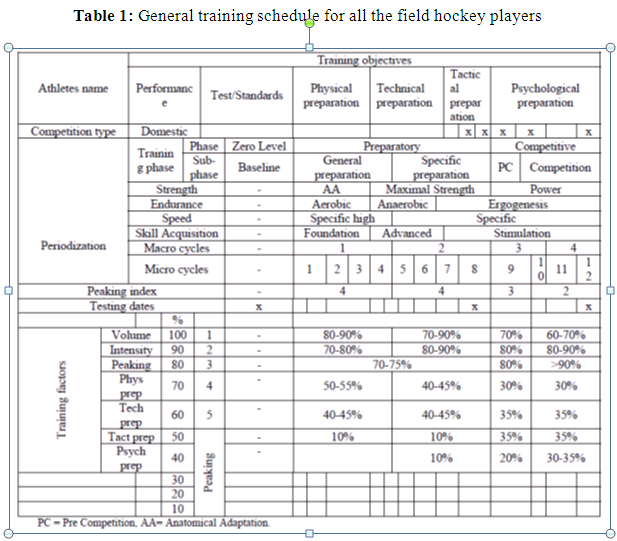
Testing procedure
Testing took place at four points during the periodized training for two year; at the beginnings of general preparation (T1), specific preparation (T2), competition (T3) phases of training and peak (T4). The selected variables speed, power, abdominal strength endurance, arm strength endurance and cardio respiratory endurance was assessed on all testing sessions a schematic figure of the periodized year can be found in figure 1.
Figure 1 : A schematic representation of the periodized training year of the RDT Hockey Academy, Anantapur, Andhra Pradesh male hockey team. The different training phases, as well as the testing points (T1-T4) are presented.
June |
July |
Aug |
Sep |
Oct |
Nov |
Dec |
Jan |
Feb |
General Preparation |
Specific Preparation |
Competition |
Peak |
|||||
T1 |
T2 |
T3 |
T4 |
|||||
The study commenced after the end of the previous transition season and at the beginning of the general preparation phase of training. The training year was divided into four mesocycles (general preparation, June to August; specific preparation, September to November; competition, December & January) and Peak (February). Training for general preparation followed a low intensity, high volume' build up (60-70% maximum heart rate and 8-12 hours training over a weekend). The training progressed to 'high intensity, low volume' (85% maximum heart rate and 6 hours over a weekend) at competition. The training focus also changed from developing the relevant components of fitness to maintenance and game preparation. The training weekends were designed to increase the player's training loads in the general preparation phase while increasing the intensity and sport-specific training during the latter specific preparation and competition stages. A similar approach was followed for the games and tournaments, where more difficult tournaments were entered later in the year. Two reduced-training periods were used, one at the end of the general preparatory phase and the other at the end of the specific preparation phase. Finally, it is important to note that the periodized training year presented above relates to the physical training completed for the state squad only. The players all trained in RDT Hockey Academy, Anantapur, Andhra Pradesh it is possible to quantify exact training loads. The tests conducted on all testing session were in the order. This order was followed to minimize the effects of previous tests on subsequent test performance, as suggested by the American College of Sports Medicine (1995). The same order was followed for all testing sessions. The equipment was calibrated according to manufacturers' standardized procedures.
All subjects were familiarized with the procedures prior to testing. Sport-specific testing had been used frequently as part of the training programme, while for the laboratory-based tests the subjects undertook specific familiarization trials prior to the testing sessions. The subjects had been instructed to refrain from strenuous exercise for forty-eight hours prior to testing and to avoid food and caffeine intake for two hours preceding the assessments. All subjects completed testing at the same time of day to avoid any circadian rhythm effects (Atkinson & Reilly, 1996).
Tests
Aerobic capacity (VO2 max) was estimated from 2400 meters run. The following equation can be used to estimate VO2max.
VO2max (ml/kg/min) = 3.5 + 483 / (time in minutes)
Statistical analyses
Descriptive statistics were calculated for all variables. A two way repeated measures analysis of variance (ANOVA) was utilized to determine significant differences for each variable between the testing sessions. Scheffé S post-hoc test was used to locate differences between testing sessions. Significance level was set at P ≤ 0.05. All statistical analyses were conducted using SPSS 11.5 version.
Results
Descriptive (mean ± SD) of the results can be found in table 2. Two-way repeated measures of analysis of variance (ANOVA) on aerobic capacity indicated significant differences between periodical evaluation years (F = 5.14, p < 0.05), testing sessions (F = 12.23, p < 0.05) and interaction (F = 4.02, p < 0.05). Since interaction is significant simple effect was applied. RDT Hockey Academy boys showed significant changes in aerobic capacity throughout the season and periodical evaluation years. The simple effect was calculated and found Testing sessions (T1,T3, T4) irrespective of periodical evaluation year showed significant difference and irrespective of testing sessions and periodical evaluation year 2008 - 09. The Scheffé S post-hoc test was applied for aerobic capacity.
Table 2: Descriptive and F value of Aerobic capacity
Testing Session |
Periodical evaluation years (ml/kg/min) |
F Value |
||||
Periodical evaluation years |
Testing session |
Interaction |
||||
2007 - 08 |
2008 - 09 |
|||||
T1 |
53.73±3.69 |
56.01±4.25 |
5.14* |
12.23* |
4.02* |
|
T2 |
55.45±3.39 |
55.09±3.46 |
||||
T3 |
55.44±3.29 |
58.78±3.26 |
||||
T4 |
56.64±3.50 |
58.65±3.40 |
||||
*Significant at 0.05 level of confidence
The table value required for significance at 0.05 level of confidence with df 1 and 44 is 4.084; df 3 and 132 is 2.6755.
From Table 3, Post-hoc analysis revealed that when testing sessions are compared between two years showed significant differences on T1, T3 and T4. The aerobic capacity showed significant improvement from first year to second year about 4.07%, 5.68% and 3.42% ml/kg/min.
Table 3: Scheffé S post-hoc test on different phases between two periodized years
Testing session |
2007-08 |
2008-09 |
MD |
CI |
% |
T1 |
53.732 |
56.019 |
2.287* |
1.537 |
4.07 |
T2 |
55.455 |
55.095 |
0.36 |
1.537 |
-0.65 |
T3 |
55.447 |
58.780 |
3.334* |
1.537 |
5.68 |
T4 |
56.644 |
58.655 |
2.011* |
1.537 |
3.42 |
*Significant at 0.05 level of confidence
From table 4, Post-hoc analysis revealed that differences exist within a year (2007 - 08) on aerobic capacity. The changes in aerobic capacity noticed between T1-T4, this shows that aerobic capacity increases toward the end of the season by 5.13% ml/kg/min.
Table 4: Post hoc test among different phases of training during the year 2007 - 2008
P1 |
P2 |
C1 |
C2 |
MD |
CI |
53.732 |
55.4552 |
1.7232 |
2.201 |
||
53.732 |
55.4465 |
1.7145 |
2.201 |
||
53.732 |
56.6438 |
2.9118* |
2.201 |
||
55.4552 |
55.4465 |
0.0087 |
2.201 |
||
55.4552 |
56.6438 |
1.1886 |
2.201 |
||
55.4465 |
56.6438 |
1.1973 |
2.201 |
*Significant at 0.05 level of confidence
The graphical representation of the data on different phases of training during the year 2007-2008 is presented in figure 2.
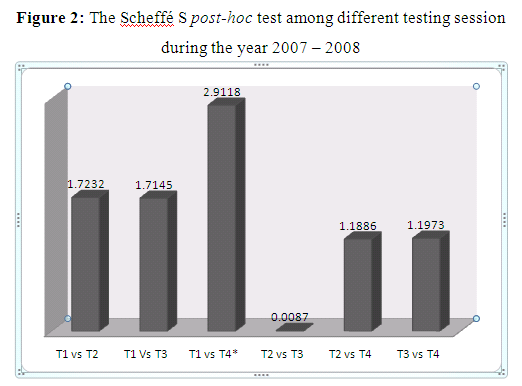
From table 5, Post-hoc analysis revealed that differences exist within a year (2008 - 09) on aerobic capacity. The changes in aerobic capacity noticed between T1-T3, T1-T4, T2-T3 and T2-T4 were 4.78%, 4.50%, 6.27%, and 6.06% respectively, this also shows that aerobic capacity increases toward the end of the season.
Table 5: Post hoc test among different phases of training during the year 2008 - 2009
T1 |
T2 |
T3 |
T4 |
MD |
CI |
56.0189 |
55.0952 |
0.9237 |
2.201 |
||
56.0189 |
58.7801 |
2.7612* |
2.201 |
||
56.0189 |
58.6546 |
2.6357* |
2.201 |
||
55.0952 |
58.7801 |
3.6849* |
2.201 |
||
55.0952 |
58.6546 |
3.5594* |
2.201 |
||
58.7801 |
58.6546 |
0.1255 |
2.201 |
*Significant at 0.05 level of confidence
The graphical representation of the data on different phases of training during the year 2008-2009 is presented in figure 3.
img src="upload/journal_images/12011-13-3.png" />
Discussion on Findings
Aerobic capacity certainly plays an important role in modern field hockey and has a major influence on technical performance and tactical choices. The present study showed an increasing trend with a significant change in maximal aerobic capacity (VO2max) in the RDT Hockey Academy male hockey players in preparatory phase and competitive phase when compared to base line data. It might be due to the long duration of the training in male players (Wilmore & Costill, 2005). Age may be a limiting factor too (Wilmore & Costill, 2005). Therefore, it can be stated that aerobic training of endurance and intermittent nature can improve the maximal aerobic capacity of the hockey players. Ideally, endurance training for hockey players should be carried out using the ball, because the player motivation is also normally considered to be higher when the ball is used. The players might then additionally develop technical and tactical skills similar to situations experienced during the game.
Interestingly, the changes in aerobic capacity occurred mid-season while there was no any noticeable decline towards the end of the two competitive seasons. The observation of improved mid-season physiological performances is probably due to a number of interrelated factors. The training and competition at this stage contributed to the improvement of aerobic capacity. In addition, the accumulative effect of minor injuries, reduced opportunities for aerobic conditioning training, and general fatigue could all be factors reducing aerobic capacity at that test occasion (Helgerud et al., 2001; Reilly et al., 2000).
However, athletes with adequately developed aerobic capacities generally showed no change in VO2max after training programs or competitive seasons. Research in athletes in 'technical' sports in which performance is principally determined by skill, have suggested either reduced or unchanged aerobic fitness following training and competition seasons. Elite junior female and male speed skaters also showed similar VO2max levels before, during, and after a competitive season (van Ingen Schenau, et al., 1992). This is consistent with the observation of a high genetic contribution to VO2 max performance, thus probably restricting the potential for improvement (Bouchard et al., 1992; Edwards et al., 2003), especially in elite athletes with already well-developed exercise capacities. Nevertheless, a previous study demonstrated significant improvements in the VO2 max test performances of elite youth players as a consequence of specific aerobic training (Helgerud et al., 2001) but it is likely that those gains are probably, in part, attributable to maturation. Therefore, it is possible that properly designed training program can still improve aerobic capacity.
Conclusions
1) Aerobic capacity remains unstable across periodized years for RDT Hockey Academy male hockey players.
2) These players tended to attain optimal performances at the mid-season interval over the 2 seasons.
References
1. Lin, Y., T., and Chang, C., K. (2009). Monitoring the training effect in different periods in elite athletes. International Journal of Sport and Exercise Science, 1(1): 15-22.
2. T.O. Bompa. (1999). Periodization Training for Sports. Champaign, IL: Human Kinetics.
3. D. L. Montgomery. (2006). Physiological profile of professional hockey players - a longitudinal comparison. Applied Physiology Nutrition Metabolism. 31: 181-185.
4. H. A. Quinney, R. Dewart, A. Game, G. Snydmiller, D. Warburton, G. Bell. (2008). A 26 year physiological description of a National Hockey League team. Applied Physiology Nutrition Metabolism. 33: 753-760.
5. C. Tarter, L. Kirisci, R. E. Tarter, S. Weatherbee, V. Jamnik, E. J. McGuire, N. Gledhill. (2009). Use of aggregate fitness indicators to predict transition into the National Hockey League.H HJournal of Strength Conditioning ResHearch. 2009, 23: 1828-1832.
6. T. Hinrichs, J. Franke, S. Voss, W. Bloch, W. Schänzer, P. Platen. (2010). Total hemoglobin mass, iron status, and endurance capacity in elite field hockey players. Journal of Strength Conditioning Research. 2010, 24: 629-638.
7. M. T. Elferink-Gemser, C. Visscher, M. A. van Duijn, K. A. Lemmink. Development of the interval endurance capacity in elite and sub-elite youth field hockey players. British Journal of Sports Medicine, 40 (2006): 340-345.
8. J. Bloomfield, R. Polman, P. O'Donoghue, L. McNaughton. Effective speed and agility conditioning methodology for random intermittent dynamic type sports. Journal of Strength Conditioning Research. 2007, 21: 1093-10100.
9. Koutedakis, Y. (1995) Season variation in fitness parameters in competitive athletes. Sports Medicine 19, 373-392.
10. J.H. Wilmore, D.L. Costill. Physiology of Sport and Exercise. (3rd ed.) Champaign IL: Human Kinetics, 2005.
11. Bouchard, C., Dionne, F.T., Simoneau, J.A. and Boulay, M.R. (1992) Genetics of aerobic and anaerobic performance. Exercise Sports Science Reviews 20, 27-35.
12. Edwards, A.M., Clark, N.A. and Macfadyen, A.M. (2003a) Lactate and ventilatory thresholds reflect the training status of professional soccer players where maximal aerobic power is unchanged. Journal of Sports Science and Medicine 1, 23-29.
13. Reilly, T., Bangsbo, J. and Franks, A. (2000) Anthropometric and physiological predispositions for elite soccer. Journal of Sports Sciences 18, 669-683.
14. Helgerud, J., Engen, L.C., Wisloff, U. and Hoff, J. (2001) Aerobic endurance training improves soccer performance. Medicine and Science in Sports and Exercise 33, 1925-1931.
15. van Ingen Schenau, G.J., Bakker, F.C., de Groot, G., and de Koning, J.J. (1992). Supramaximal cycle tests do not detect seasonal progression in performance in groups of elite speed skaters. Eur J Appl Physiol Occup Physiol, 64, 292-297.
CORRELATIONAL STUDY OF EYE HAND CO-ORDINATION AND HAND REACTION TIME AMONG HANDBALL PLAYERS
Satinder Paul
ABSTRACT
The purpose of this study was to find out the correlation of eye-hand co-ordination and reaction time among handball players. The study were conducted on 20 Handball Players, State Level tournament held at Sujanpur Tira, Himachal Pradesh, North India during the year 2009-2010. The age group of players ranged from 17-21 years and all the sample selected from random basis. To find out the correlation between eye-hand coordination and hand reaction time, products Moment Correlation Method was used.
Key words: Co-ordination, Reaction Time, Handball Player.
INTRODUCTION
Reaction time-is the time elapsed between the stimulus given and the initiation of the response to it. In other words reaction time may be defined as "the interval of time between the presentation of stimulus and initiation of the response." Johnson and Nelson 1982, Reaction time is affected by a number of variables. It is greatly affected by the type of sensory stimulus such as visual, auditory, touch, fatigue, motivation muscular tension, age and physique etc. There are many occasion in sports where speed of reaction and speed of movement are very vital factors. In general fast reaction are characteristics of great athletes in the sports performance at the higher competitive level. The results of sports competitions set world records by small fraction of seconds. In a context, where races and events are won by fraction of sec; the role of reaction time becomes very significant.
Co-ordination is one's ability to efficiently and effectively integrate the movements of different body parts especially during quick movement actions of various types.
The level of co-ordination between different players are sports specific and depends upon coaching of sports skills. The co-ordination of individuals own body systems is a general motor ability which is predominantly one's innate quality. It may be greatly improved with coordination improving training and general practice of basic physical activities involving more than one muscle group actions like jumping throwing, catching and zigzag etc.
METHODOLOGY
Procedure
The study was conducted on 20 male handball players, state level tournament held at Sujanpur Tira, Himachal Pradesh, North Zone of the India during the year 2009-2010, the age group of the samples ranged from 17-21 years and all the samples selected randomly.
TOOLS
To assess the reaction time and co-ordination of the subjects, Nelson Hand Reaction Time Test and Eye Hand Co-ordination Test (Ball Transfer) was used.
ANALYSIS OF DATA AND DISCUSSION
The main purpose of this study was to correlate eye hand co-ordination and hand reaction time of Handball players. The eye hand co-ordination was measured with Ball Transfer Test and hand reaction time was measured with Nelson Hand Reaction Time Test. The raw data was calculated with the Formula i.e. Product Moment Correlation Method was used.

The collected data of eye hand co-ordination and hand reaction time is presented in Table No.1
Table No.1
Correlation of Eye Hand Co-ordination and Hand Reaction Time of Handball Players
|
∑ x2 |
∑ y2 |
∑ xy |
Rxy |
|
3478.6 |
2.94 |
98.78 |
1.01 |
From Table no. 1, r = 1.01 and N=20, to verify the significance of r at 95% confidence the tabulated value of r was seen from the table for N-2 = 18 degree of freedom. The value of r at .05 is .44 and hence, tabulated r is less than calculated r; since calculated r = 1.01 is greater than tabulated r = .44 and hence correlation between eye hand co-ordination and hand reaction time of handball players, is significant at 95% confidence and also verify the significance of r at 99%. The value of r at .01 is .56 hence, tabulated r is less than calculated r, and thus correlation between eye hand co-ordination and hand reaction time of handball players, is significant at 99% confidence.
CONCLUSION
On the basis of data gathered and statistical interpretation results indicates that:
· There is a positive correlation between eye-hand co-ordination and hand reaction time.
· Most of the handball players were better in eye hand coordination as well as hand reaction time.
REFERENCES
Barrow, H.M. and Nary, R.M., A Practical Approach to Measurement in Physical Education Philadelphia: Lea and Febiger, 1979.
Kamlesh M.L; Psychology of Physical education and sports, New Delhi; 1983.
Kansal, D.K; Test and Measurement in Sports and Physical Education, New Delhi; D.V.S Pub; 1996.
Rushall, B.S; Mental Skills training for sports (2nd ed.); Belconnen, ACT, Australia; Australian Coaching Council.
Uppal, A.K., Principal of Sports Training, Friends Publication, Delhi, 2001.

